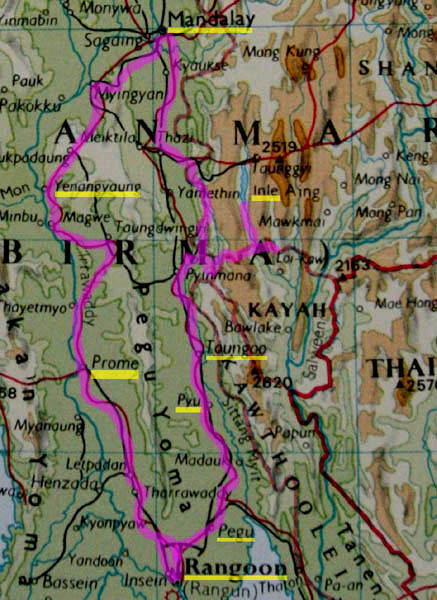Introduction
This is an abridged description of a trip to Myanmar (the old Burma) in October 2004. The intention is to give a first hand personal experience of how we did get to and through the country from Yangoon (Rangoon) via Bago (Pego), Toungoo, Kalaw, Inle, Pindaya to Mandalay and back to Yangoon via Bagan (close to Yenangyaung) and Pyay (Prome). Despite the fact that we did not book anything in advance at all (except for the flight from Frankfurt to Bangkok) and covered about 1500 km within 12 days it still was a very comfortable trip with no hassle whatsoever. Even less so because we decided to rent a van with driver and guide for the whole round trip from Yangoon. So no consideration to plan a couple of days ahead was necessary, just one day contingency for Yangoon.
Getting to Yangoon
We (Brigitte, Petra, Uli and myself) flew from Frankfurt with Qatar Airways to Bangkok (also see next travel report to Thailand) where we booked the flight with Myanmar Airline to Yangoon and return for around 110 Euro each - just two days before the departure - at the following Travel Agency in Bangkok:
Namhasin Tours
Viengtai Hotel
Rumbutree Road
Tel.: 02629-3684,02629-3935
Email: namhasin@hotmail.com
|
This is an agency with the best fares for flights, and definitely much cheaper than booking in Germany, for example. As a matter of fact another travel agency on the parallel Khao San Road, where we inquired before, was more expensive.
The visa for Myanmar was already acquired for 25 Euro from the
Myanmar Embassy in Berlin. The visa entitles for a stay of up to 30 days and can even be extended. In the Eighties it was valid only for seven days.
Arriving in Yangoon
We did get through Passport Control easily, picked up our checked-in luggage, passed Customs and went directly by taxi to the
Hotel Yoma
146, Bogyoke Aung San St
Yangoon
Email: yoma.one@mtpt400.stems.com
|
This hotel was conveniently located and most of the inner city could be reached by foot. The room rate for a double was 17 USD (with special discount of 1 USD !!!) but then 20 % tax and service charge in addition. The rooms were ok and there was a restaurant on the top floor with a view out the window onto the main street.
Before, at the airport, we had been encountered by a guy who offered us to rent a car for our trip around the country. I actually was planning to book either plane or train to be more independent like I did the circuit in even seven days in 1984. But the offer sounded well worth a consideration, so Uli and myself went to the address of the Car Rental station the guy gave us. After serious negotiation we finally accepted the offer and their "last price" to get subsequently shocked when we were asked to pay in advance. They even did not accept half now half at the end, so we declined.
There were more Rent a Car's around and we finally settled for
Myanmar Comet Tours
No(327)G/F, Bogyoke Aung San St, Waziya Cinema
Tel:(951)382897
Email: zulu@myanmar.com.mm or comettours@mail4u.com.mm
|
The whole roundtrip for 10 full days including driver and all gasoline did cost 450 USD and not to be paid in advance (an extra day extension would have been 45 USD).
What about the money? Credit cards are not widely accepted and ATMs are not around either. So bring enough cash, best in US Dollars. The official exchange rate was 7 Kyat (Myanmar currency) for 1 USD, which is ridiculous, if you can get 400 Kyats on the black market. So we did not change anything at the airport 's government banks. We went to the real market instead and found a money changer after we asked around. I exchanged 200 USD to get 16,000 Kyats (by the way, 100 Dollar bills get the best exchange rate). Petra did the same. And that was still too much for the next 11 days (but managed to spend it all, though), because Dollars were accepted almost everywhere (using the inofficial exchange rate), provided you have small denominations.
But do not rely too much on all that, because it all can change fast (more to the better). The black market exchange rate in 2007 is already more than 1200 for 1 USD. It was also said once that there is a compulsory exchange of 300 USD to 300 FEC (Foreign Currency Certificate) with no chance to change on the black market, but nobody asked us to do so at the airport. So better check it out in the internet before you go.
Driving to Bago
Next morning we were ready to leave (having an extra day for sight-seeing in Yangoon after returning as a contingency in case of a car breakdown). First stop was in Bago (Pegu is the old name).
At the first temple site we had to pay 10 USD per person. We thought that this was too much for this one temple, which even was not that impressive anyway, until we were told that three more temples in Bago were included.
Click the small picture to get it large
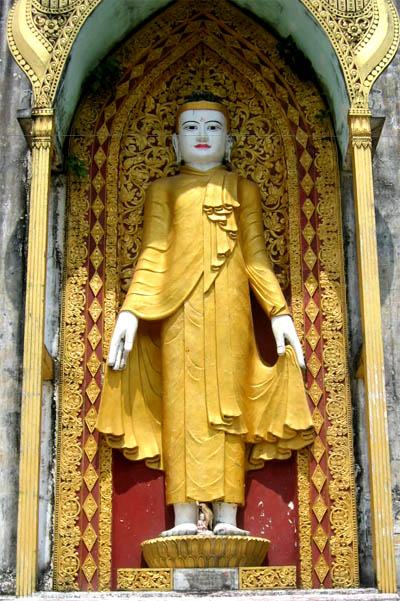
| First Buddha statue we see
|
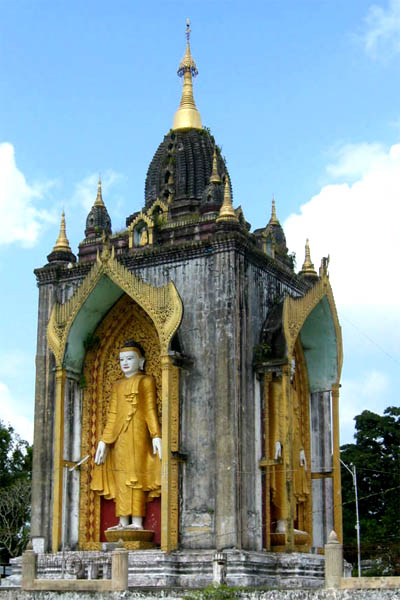
| in a temple in Bago (Pegu)
|
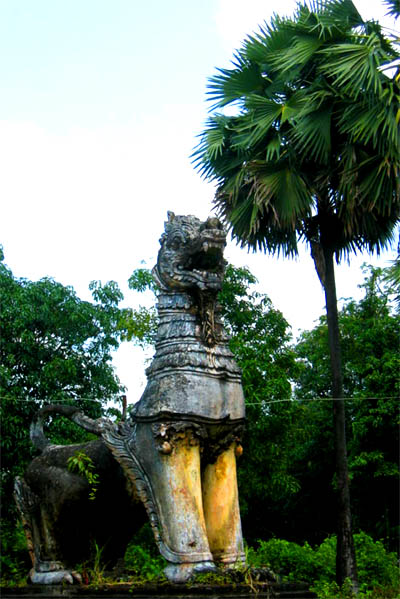
| Also first lion statue
|
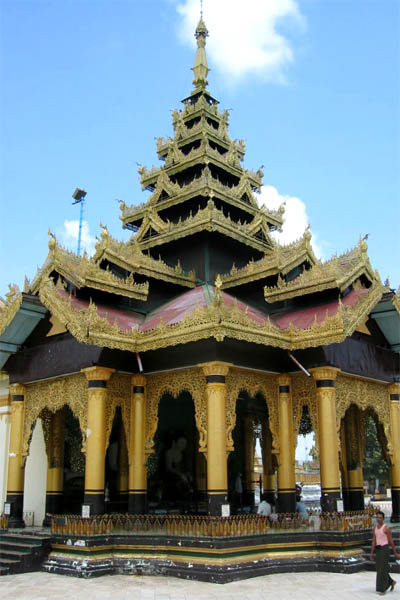
| and a temple pavillon
|
Ok, now we were content to see the second biggest pagoda in Birma - after the Shwedagon Pagoda in Yangoon - the Shewmawdaw Pagoda.
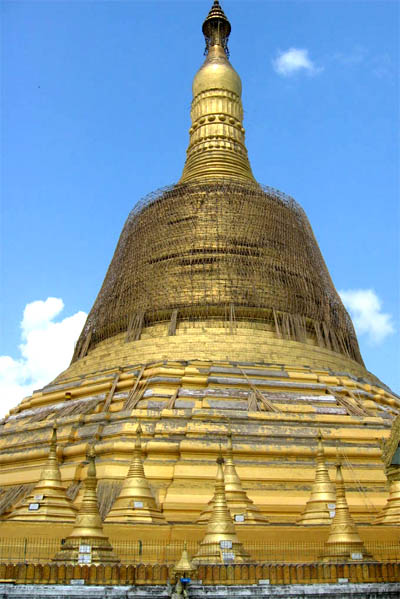
| And our first stupa in Birma,
|
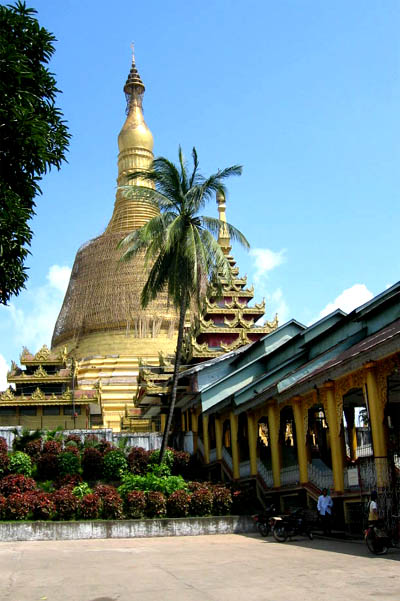
| the Shwemawdaw Pagoda
|
The whole temple area is not as large as the Shwedagon but the stupa is even with 115 meter higher. It is supposed to contain one Buddha hair and two teeth relique. The two Chinthe are lion-like creatures that guard the entrance to temple.
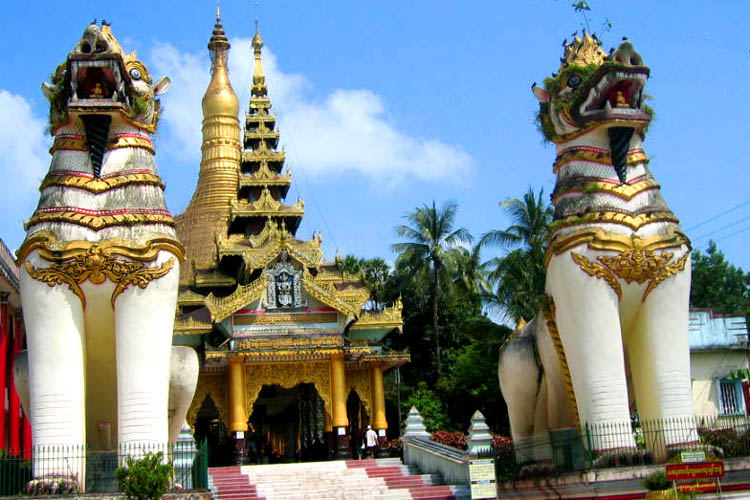
| Entrance to the Shwemawdaw Pagoda
|
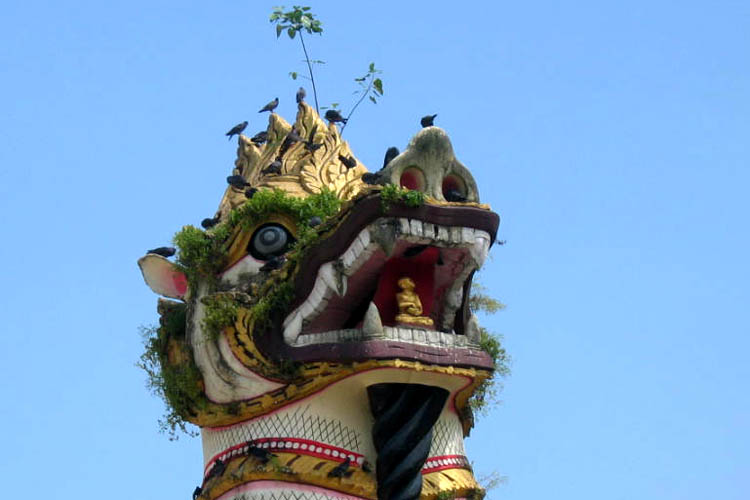
| with a Chinthe head close-up
|
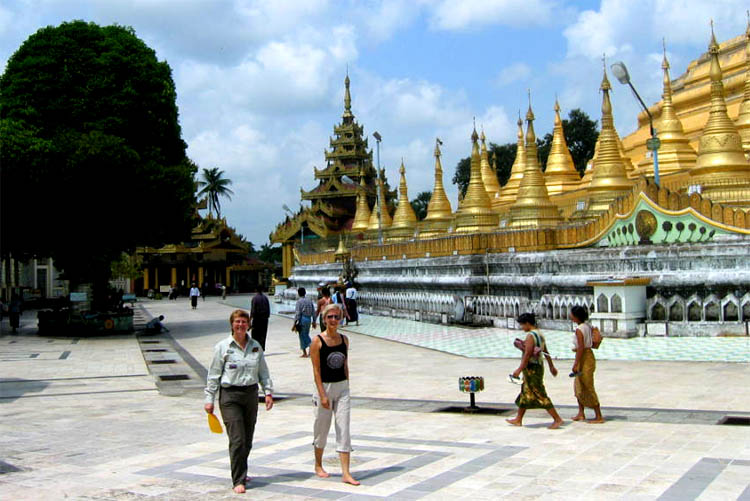
| Circumventing the pagoda leisurely
|
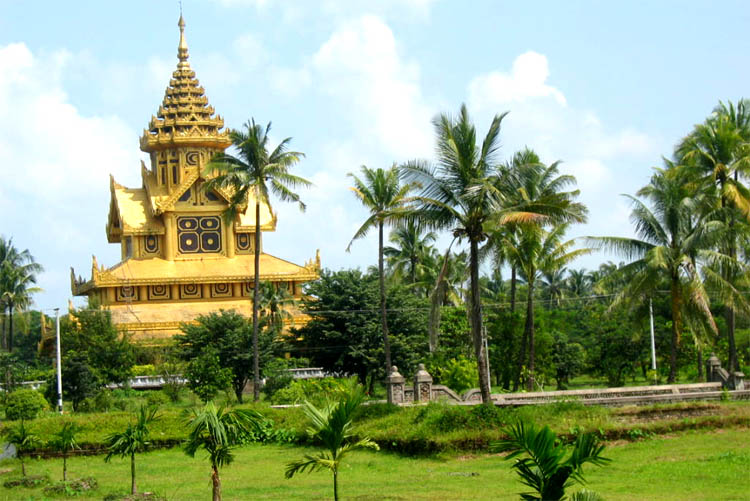
| Another temple on our way
|
Next stop in Toungoo
From Bago I would have liked to make a detour to visit the Golden Rock with the Kyaik-tiyo Pagoda (look up the guide book) but we did not have enough time, so we continued to Toungoo, where we stayed the night at the
Thiri Hotel
Toungoo, Myanmar
|
which was located a little laid back from the main road at the beginning of the town. The rooms were ok for the one night's stay. The restaurant was just at the road where we had dinner.
Getting to Kalaw
Next day we went directly to Kalaw, which became our "hub" for visiting the Inle Lake (without having to stay there overnight, since we had our car to use for all our side trips) and as the starting point for trekking to the hill tribe people.
This town lies in an altitude of 1300 meters and has a nice climate. So during the colonial period it was a cool retreat for the colonist, like Dalat in Vietnam or Darjeeling in India.
Also you can still find many of the houses in the colonial style like our hotel where we stayed for three nights, which was the
Dream Villa Motel
Yatila Street, 5-Quarter, Kalaw
Tel: 095-081-50144
|
The villa had nice rooms (the double room for three nights came up to 70 USD). The room we stayed in the first night was facing a temple along the street, where monks alternately were chanting and reading Suthras (not the Kama-Suthras) - amplified by loudspeakers - the whole night. After that first night we moved to a room in the rear, but my good night's sleep was only a little better. We just happened to be in Kalaw during a religious festival going on for several days.
Excursion to the Inle Lake
OK, first morning after breakfast we headed off by car to the town of Nyaungshwethe - right at a canal leading to the Inle Lake - where we hired a boat for the day.
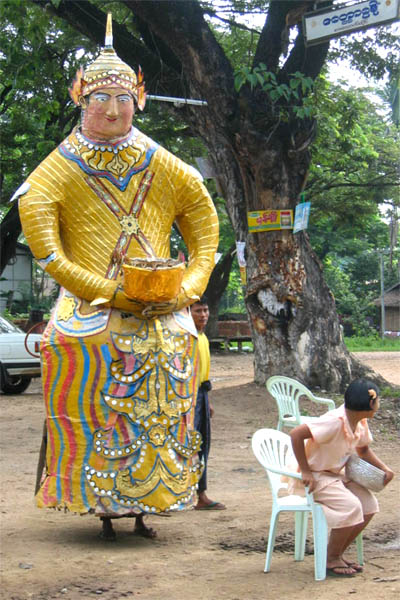
| Just an encounter of a giant puppet on the road
|
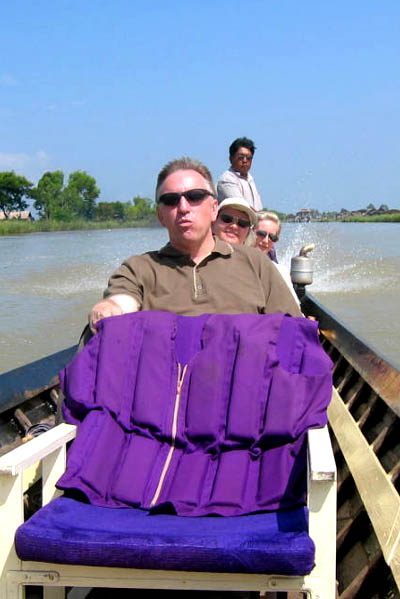
| and the first encounter with the Inle Lake
|
The Inle Lake is the largest lake in Myanmar and very flat, around three meters deep, and famous for their floating gardens and of course their one leg rowers. Can you imagine rowing a boat like that a whole day? They even had boat races during festivals. Our boat ride was very comfortable instead - sitting on cushions and letting pass the boats with natives going after their businesses.
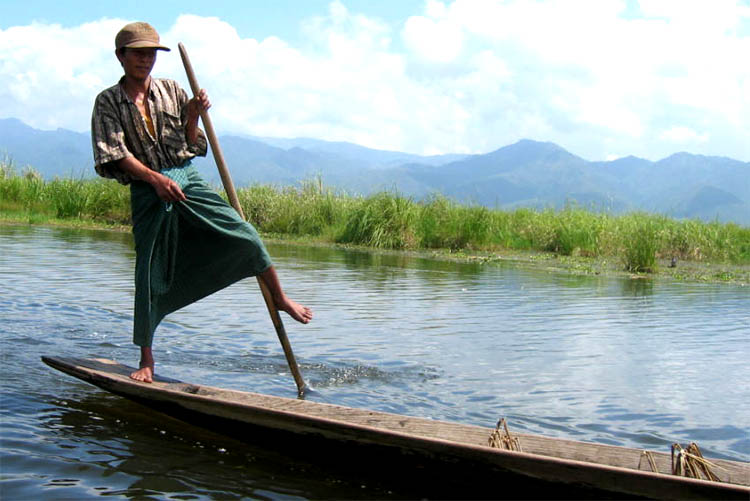
| First encounter with a "one leg rower"
|
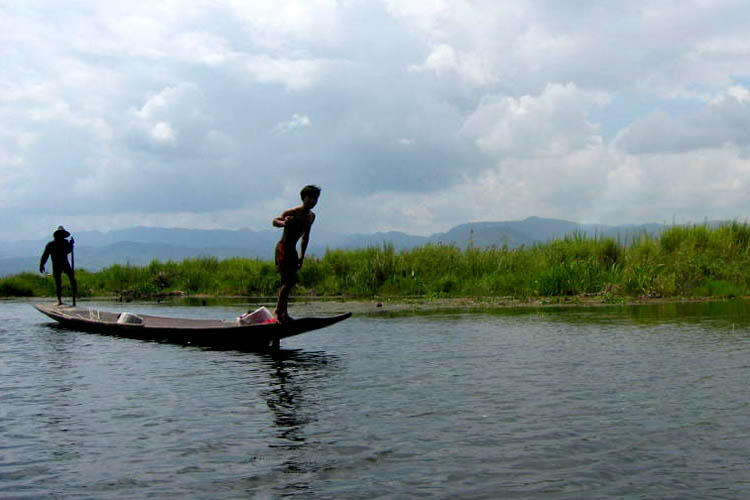
| Another encounter with two "one leg rowers"
|
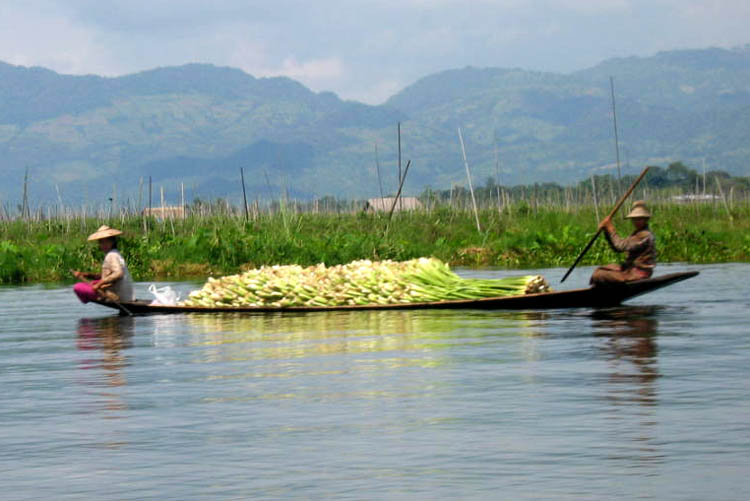
| Freight boat with vegetable cargo
|
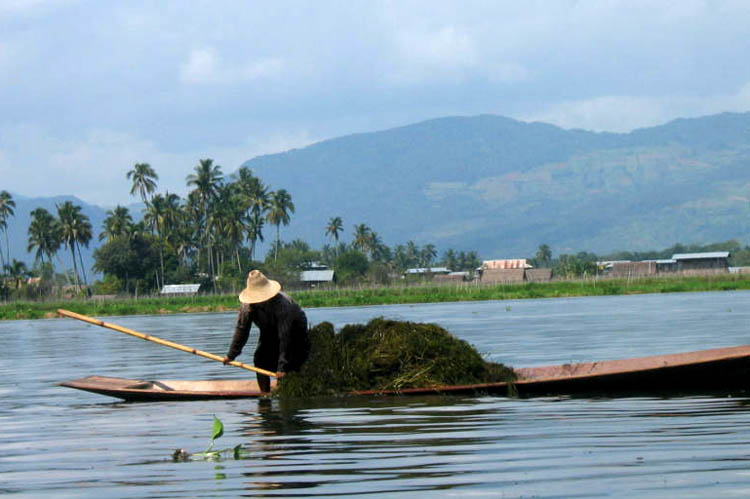
| Working hard to harvest sea grass
|
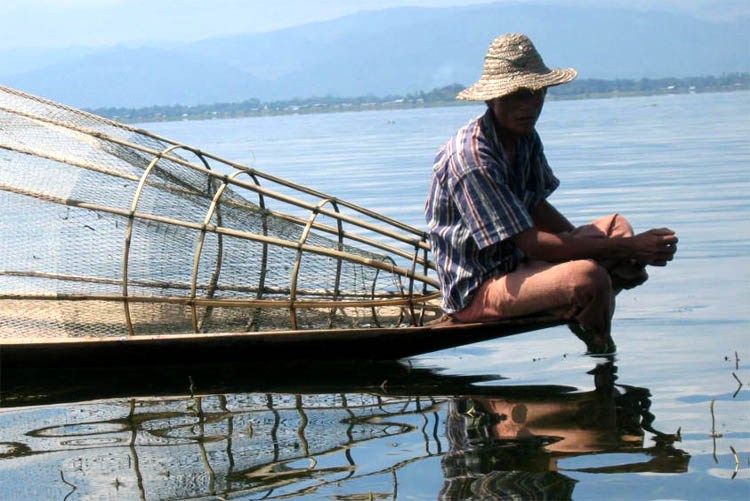
| Fisherman waiting for what?
|
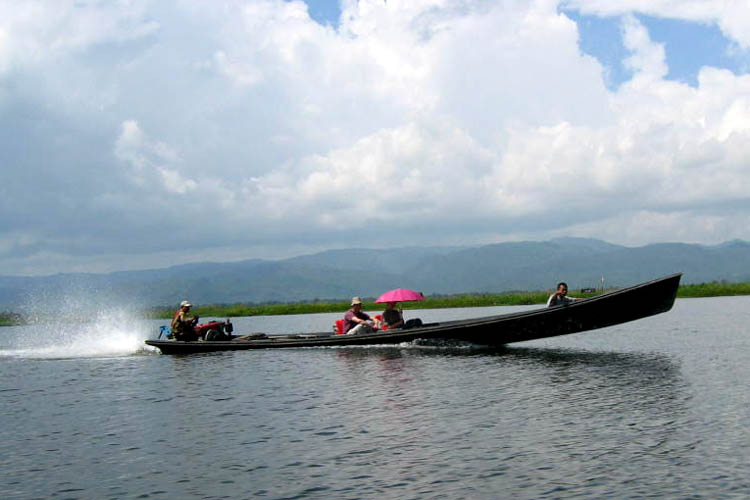
| Passenger speed boat overtaking us
|
After cruising over almost half the lake we came to the town of Ywama with it's beautiful Phaung Daw U Pagoda. We did not get in yet but visited the market first.
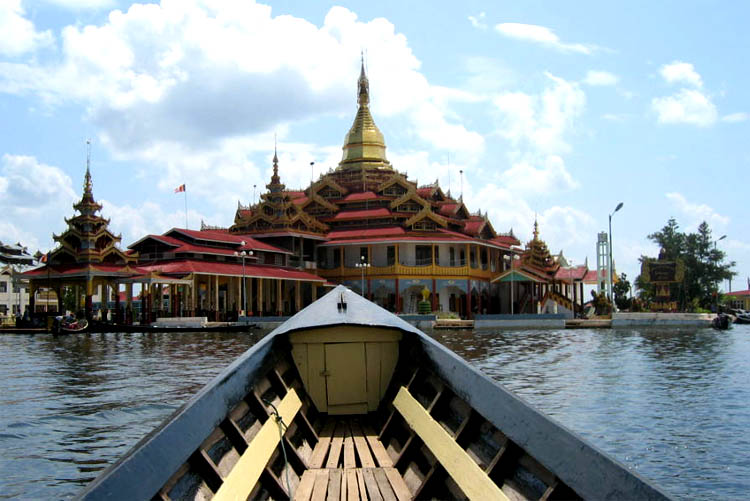
| Heading to the temple for a prayer?
|
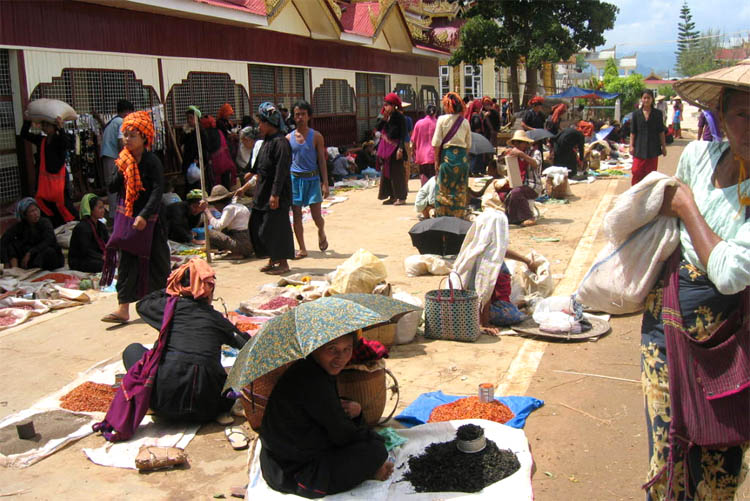
| No, first we gonna visit the market
|
The market is visited by different tribes people coming by boats from the villages around Inle, either offering their produce and/or buying household goods, etc. Unfortunately, we did not meet any Padaung women, the one with the Giraffe Neck.
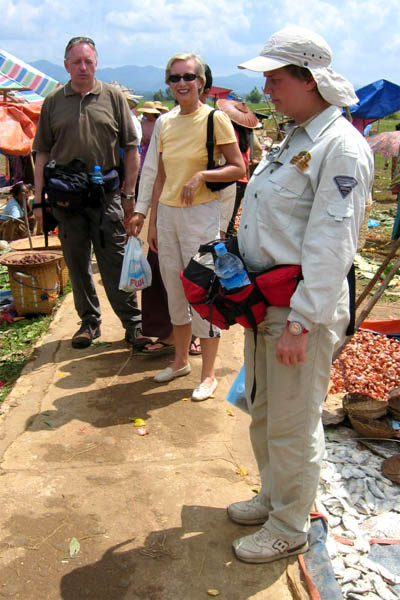
| Petra: What can I buy?
|
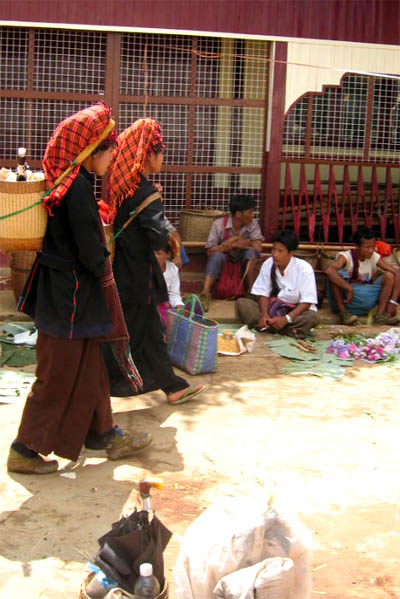
| I rather look after the girls
|
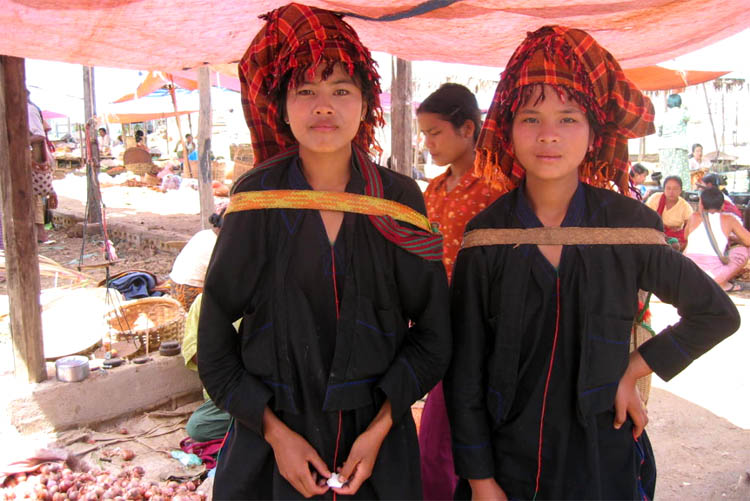
| who weren't shy at all
|
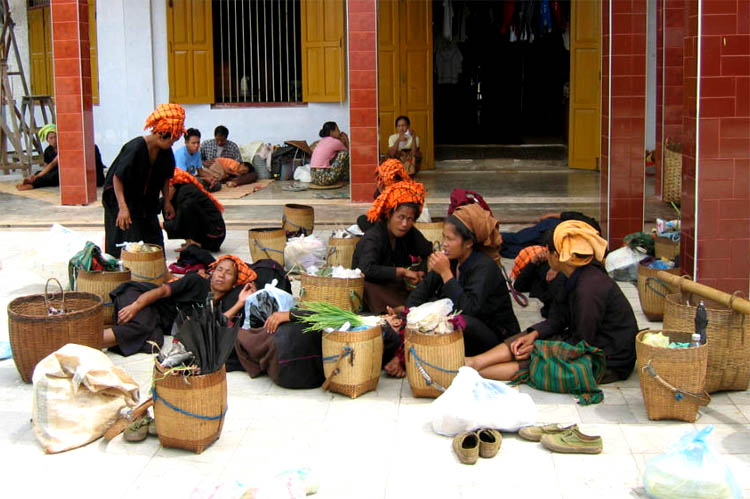
| belonging to an interesting tribe
|
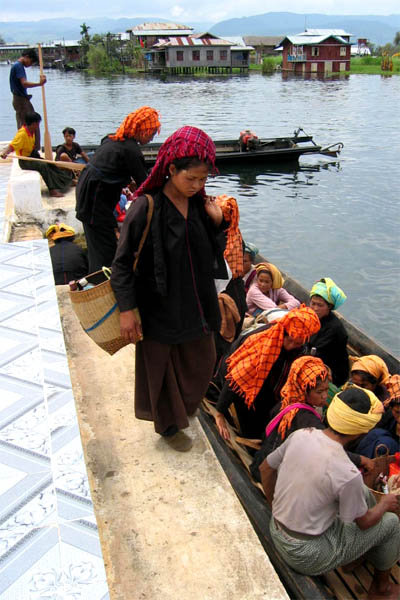
| Buyers already heading home by boat
|
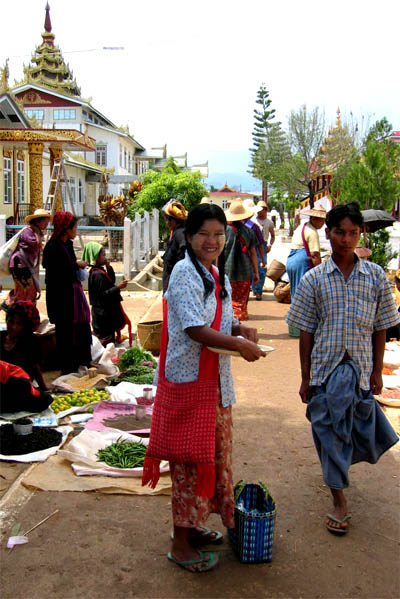
| Vendors still offering their ware
|
The village not just consists of a market of course, but people also living there in houses built on stilts right on the water. The boat is the only means of transport. For their living they are either working in the field, i.e. floating gardens or what the lake will yield or in different trades as you can see below.
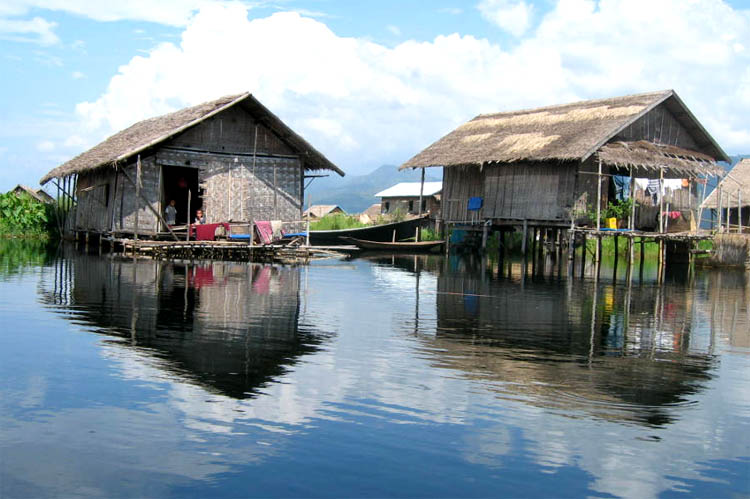
| And now inspecting the village
|
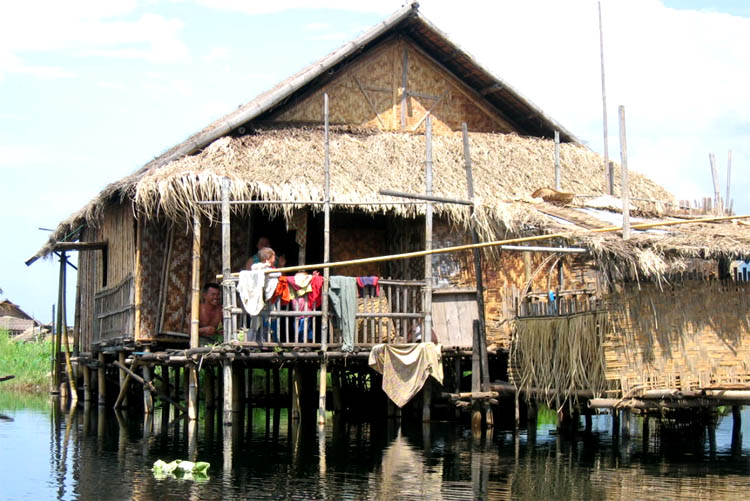
| and their houses
|
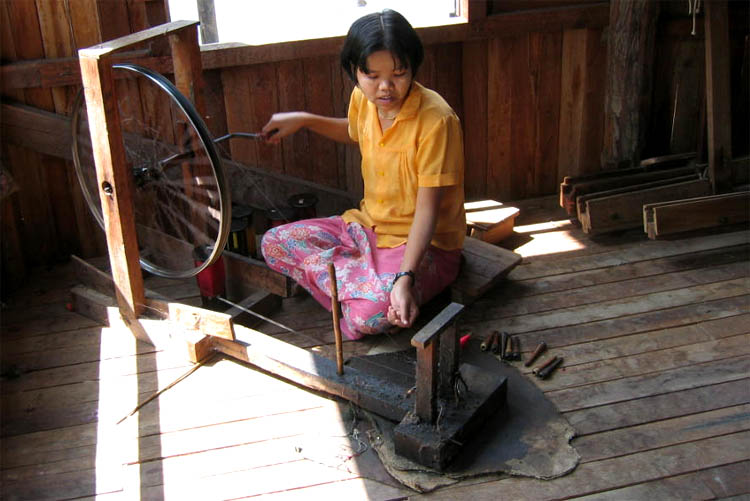
| and what their people are doing
|
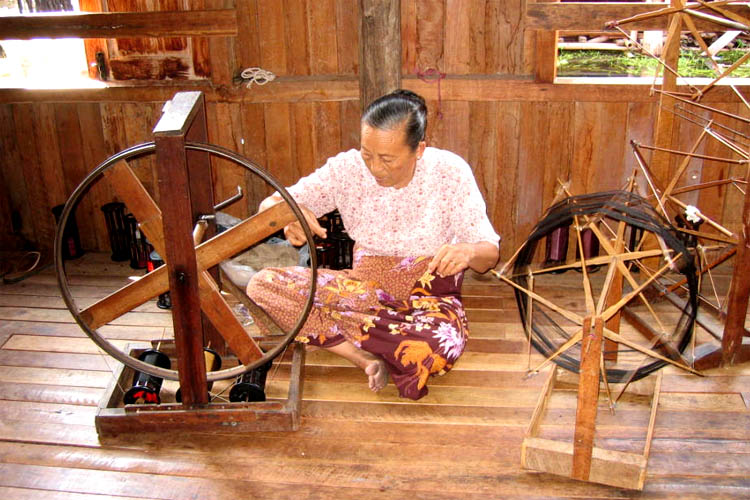
| spinning, spinning, spinning
|
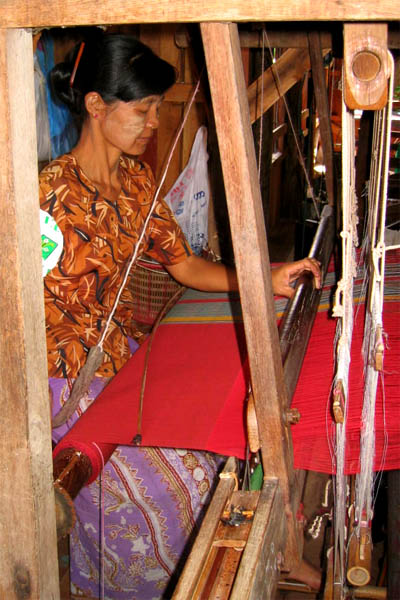
| Weaving nice patterned fabrics
|
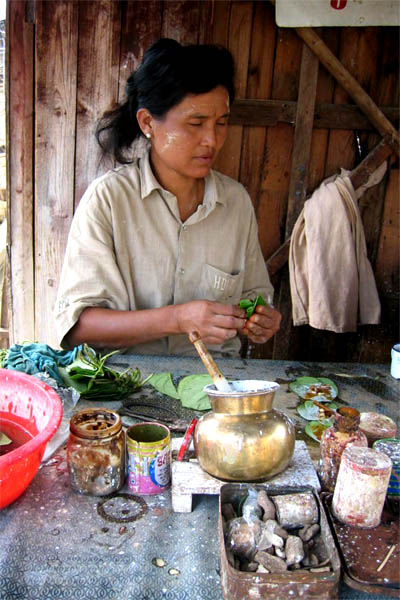
| or producing Bethelnut joints
|
The floating gardens are made of hyacinths and their branches hold the humus together. They had been mainly used to grow tomatoes, but I did not see any, maybe it was no harvesting time right now.
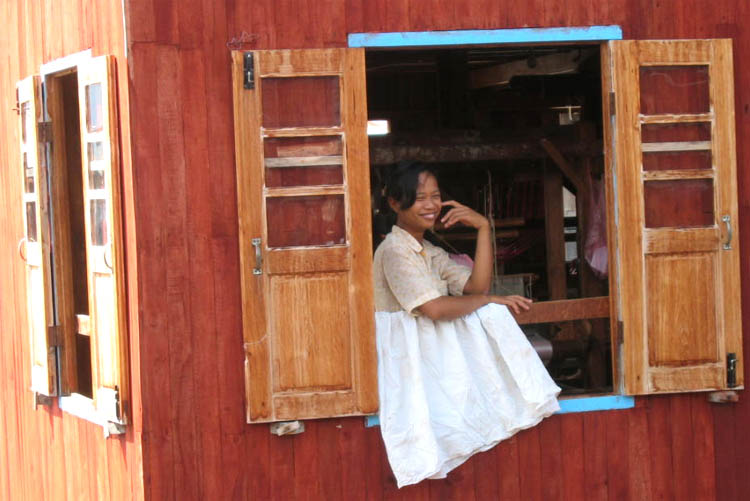
| Where is my husband?
|
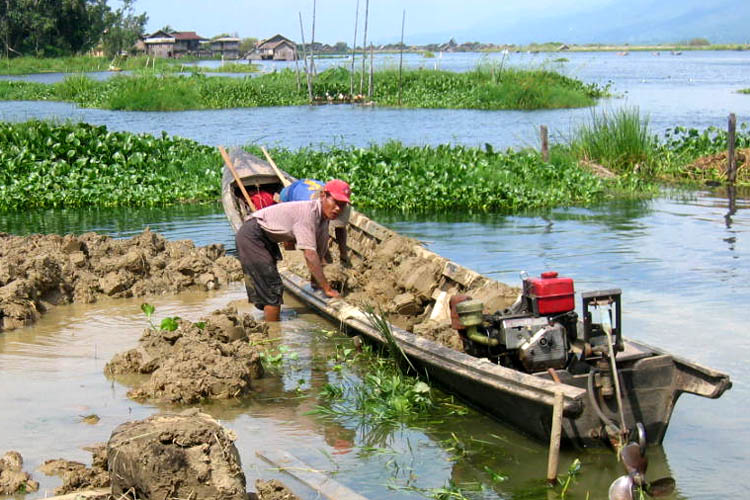
| Working hard for his floating garden
|
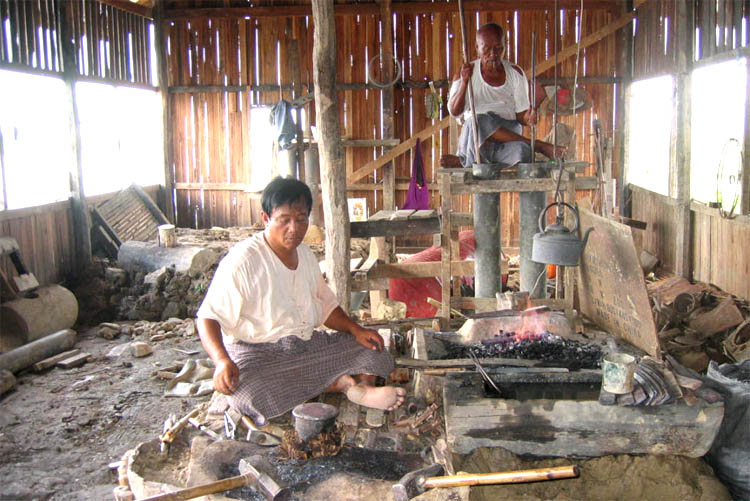
| Working as a smith
|
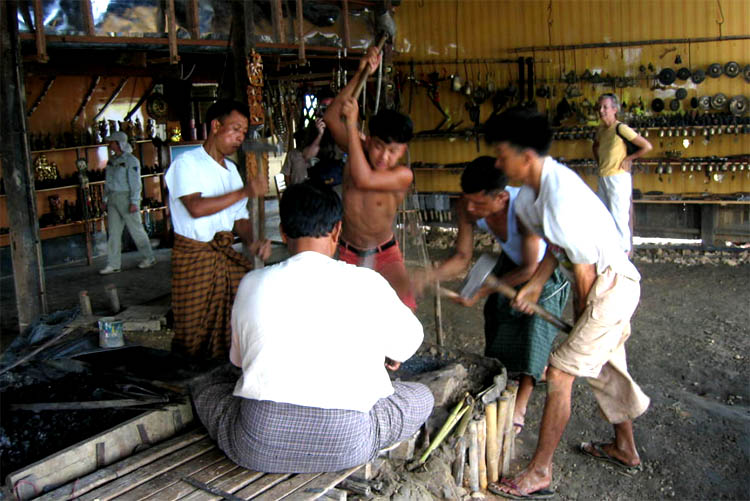
| is even harder
|
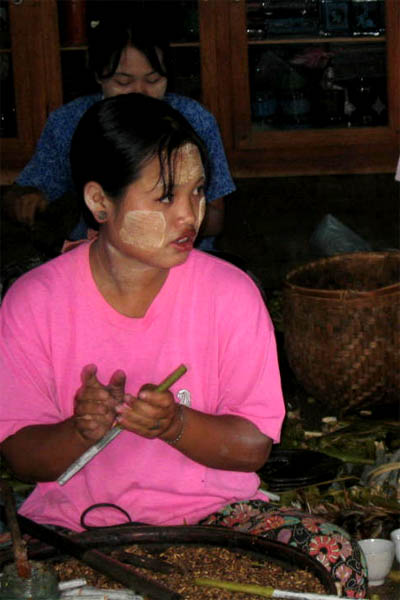
| This is much easier work
|
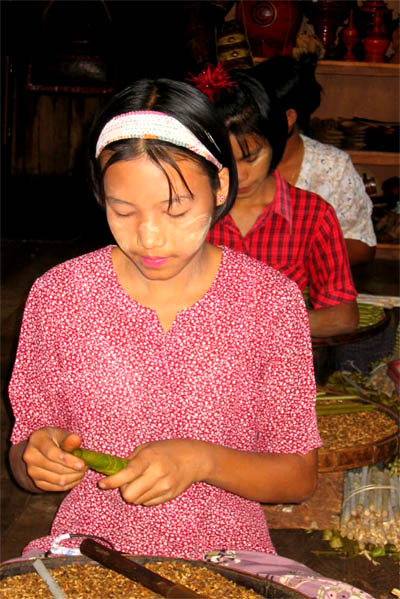
| for a girl rolling cigars
|
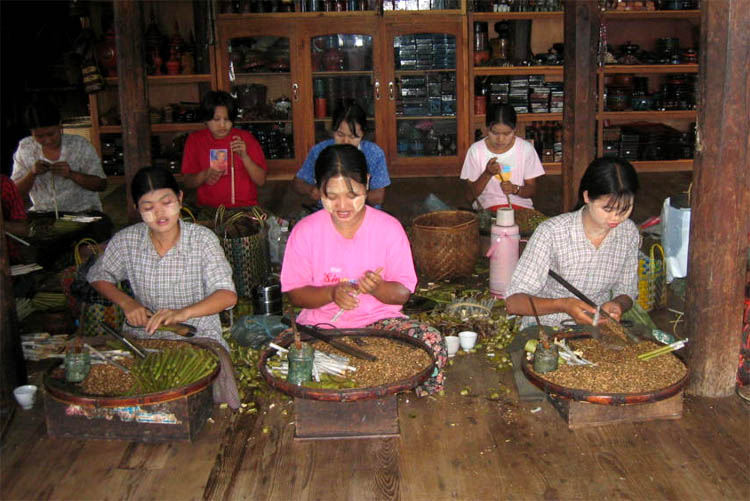
| especially working in a team
|
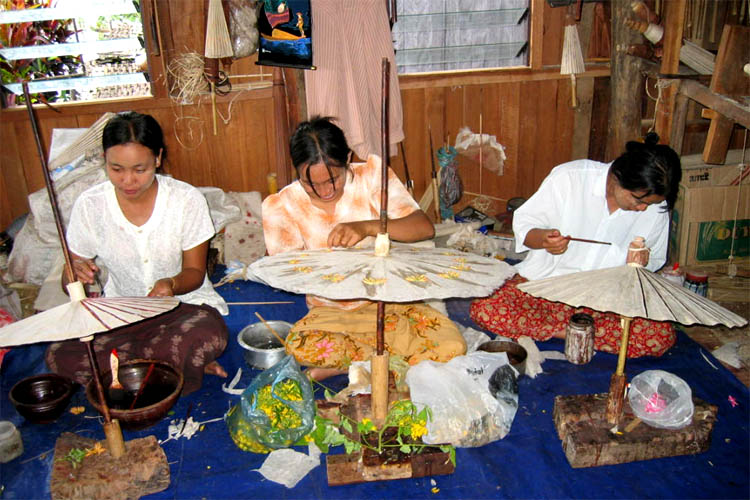
| whether making cigars or umbrellas
|
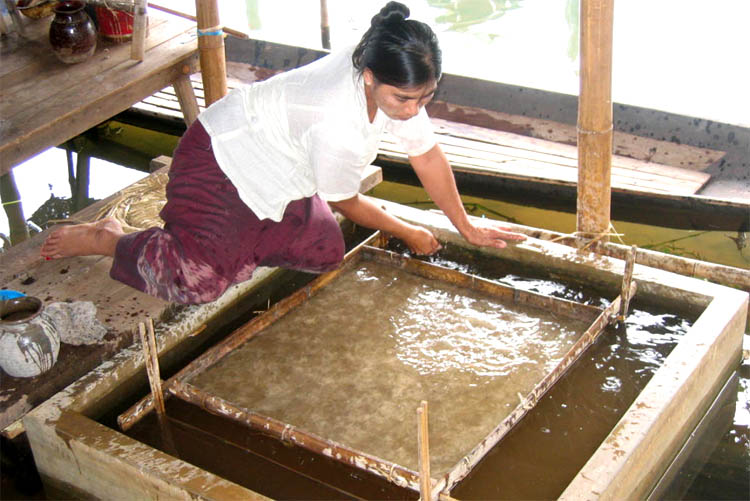
| Also paper making is an art
|
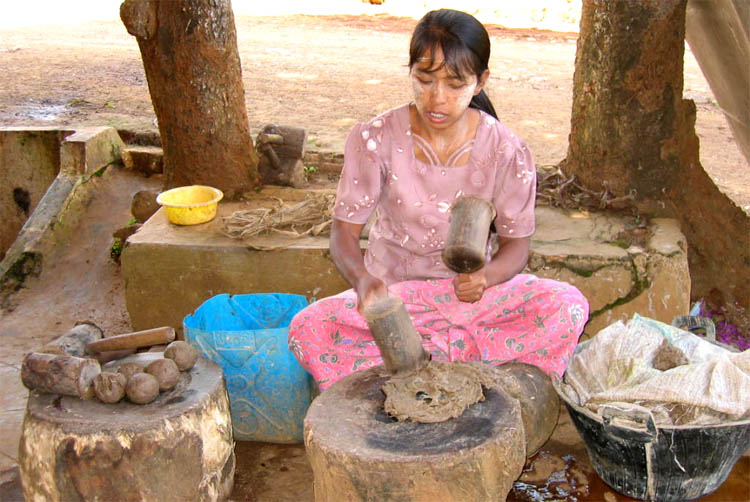
| not so making pan cake out of it
|
After visiting some souvenir shops we left this village to head for Nga Phe Kyaung, the most famous monastery in the lake. There are not many monks around there anymore but more so cats. It seems to be a pastime by the monks to train cats to jump through rings - beside praying.
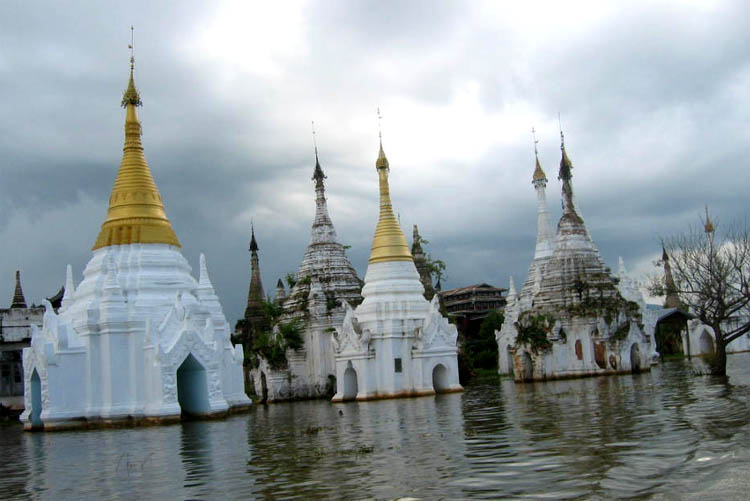
| Pagodas in the lake we see.
|
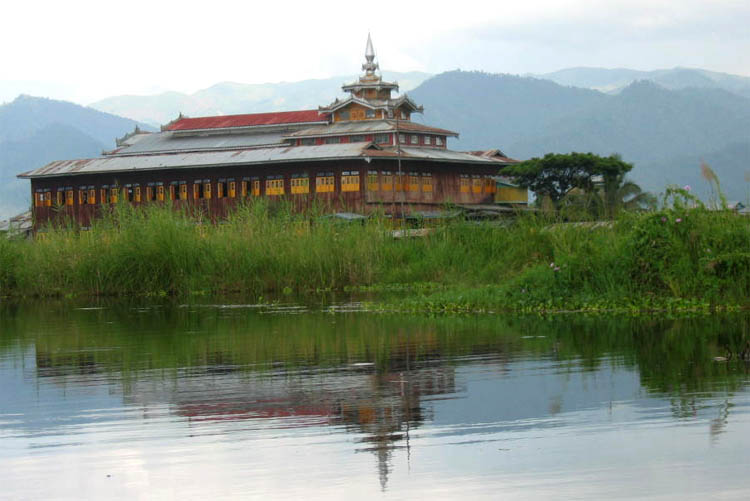
| before we get to the monastry
|
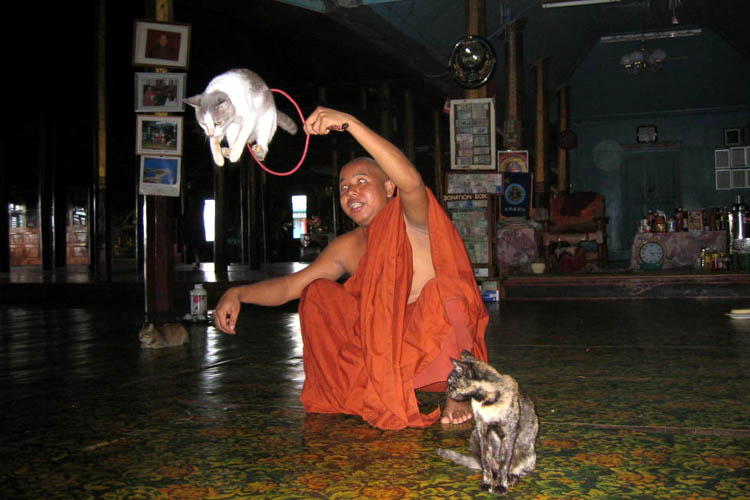
| where the monks are training cats
|
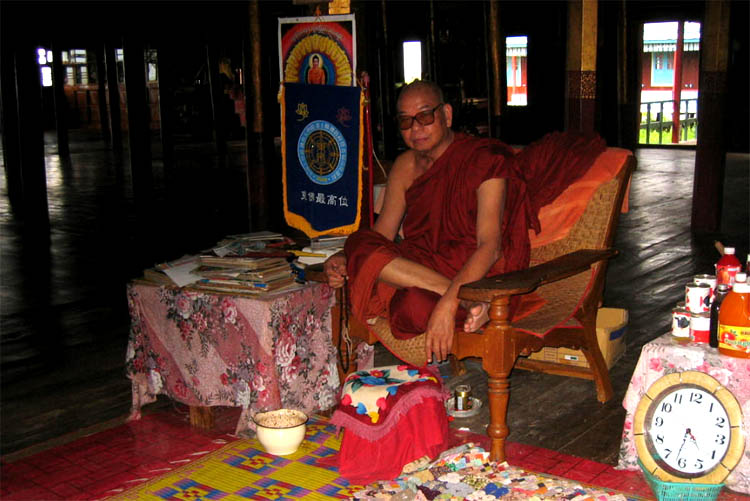
| and the prior does nothing but relax
|
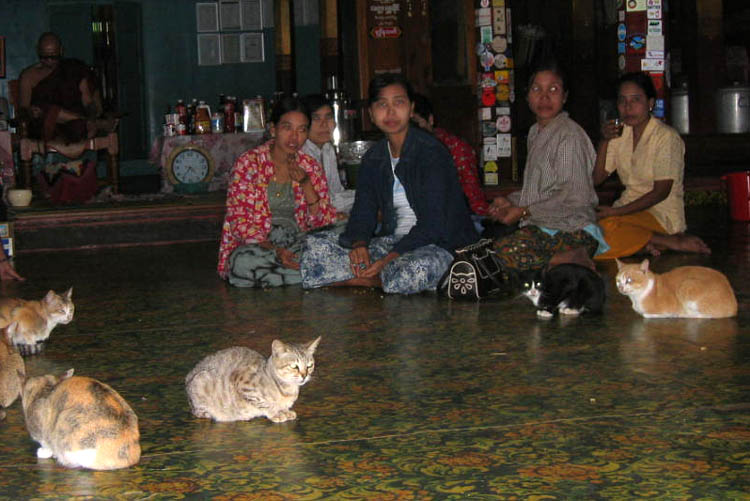
| The visitors also just make a break
|
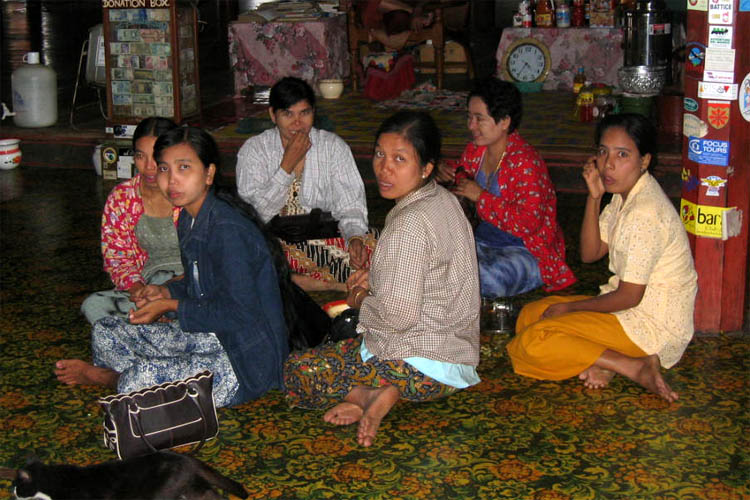
| not much praying is at stake
|
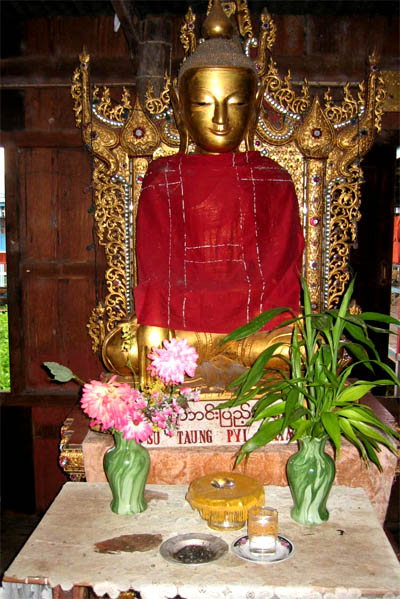
| Offerings were made abound
|
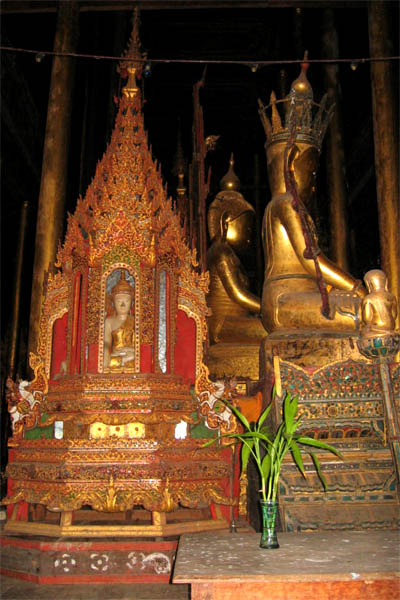
| to nice Buddhas all around
|
That was the day. We have seen so much. Now is the time to race back to town.
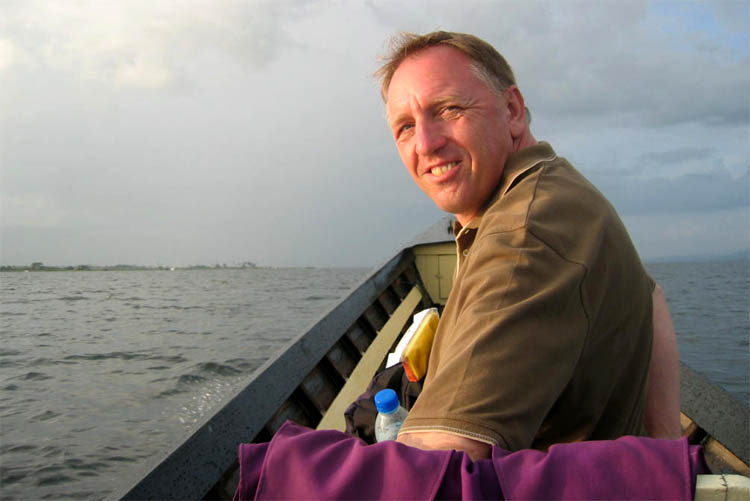
| Now we get back with full power
|
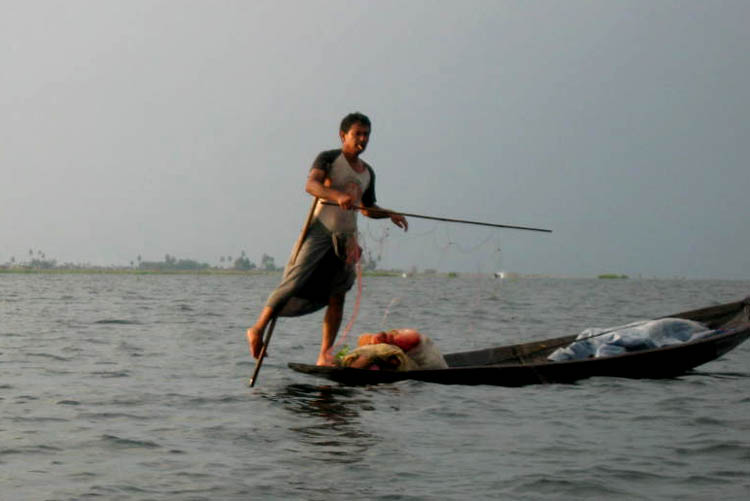
| with a pity look a the last "one leg rower"
|
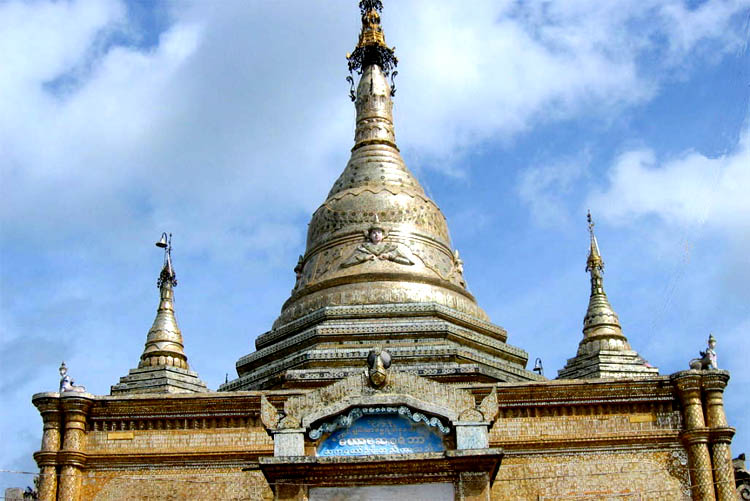
| Back to Kalaw, our town, to sleep alright
|
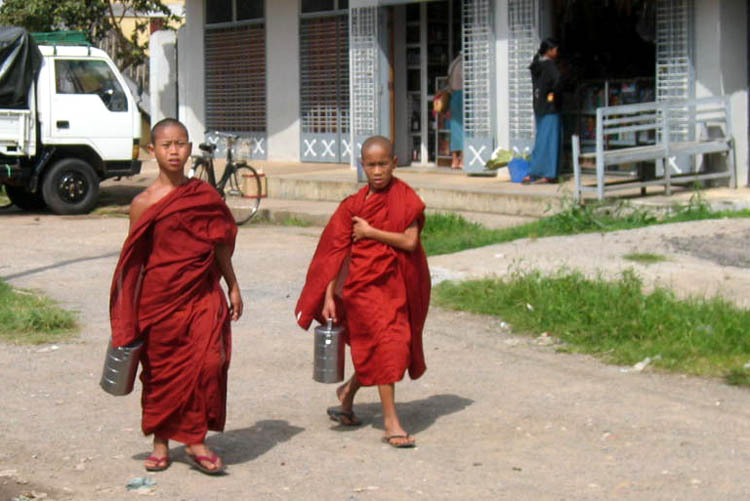
| but the monks did get busy day and night
|
Visiting the market in Kalaw
Next morning we went to the famous market in Kalaw, which takes place every 5 days (alternating with other villages), where also all the tribes people come from the mountains. It was one of the most colorful markets we have seen in Myanmar.
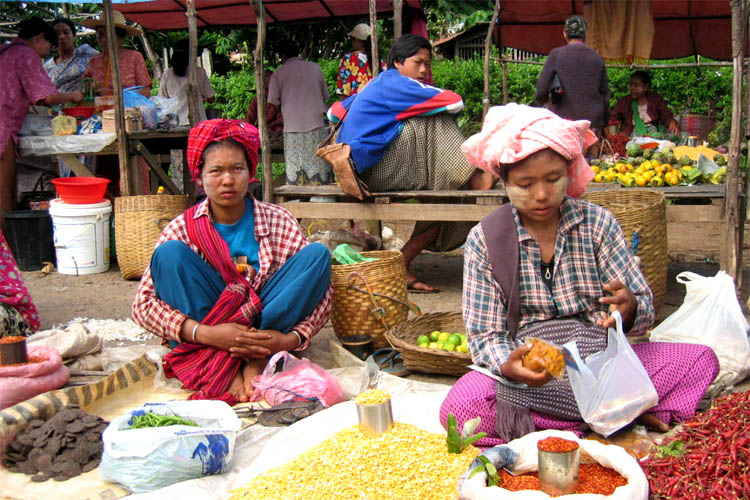
| That wakes me up after a sleepless night
|
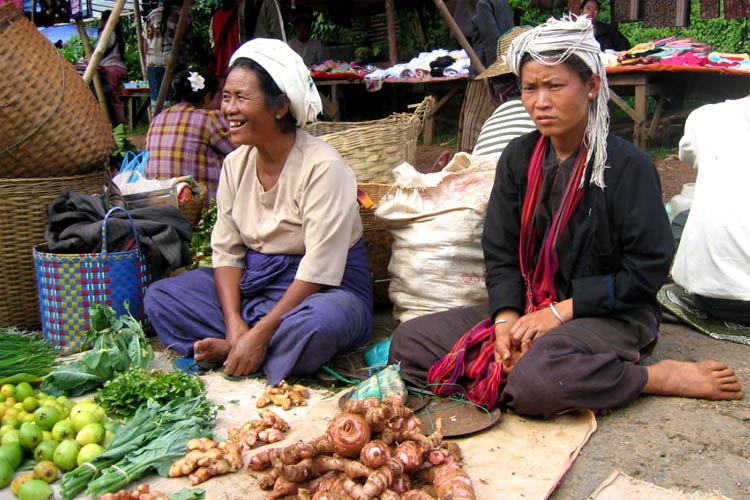
| the colorful market with happy women, what a sight
|
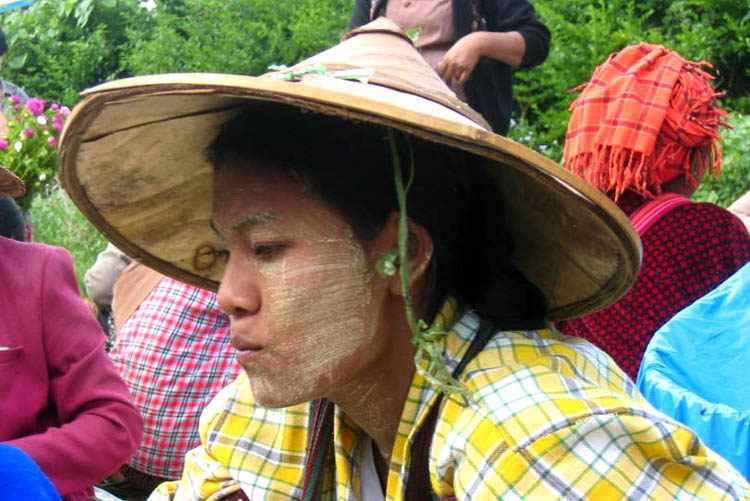
| And a beautiful woman painted white
|
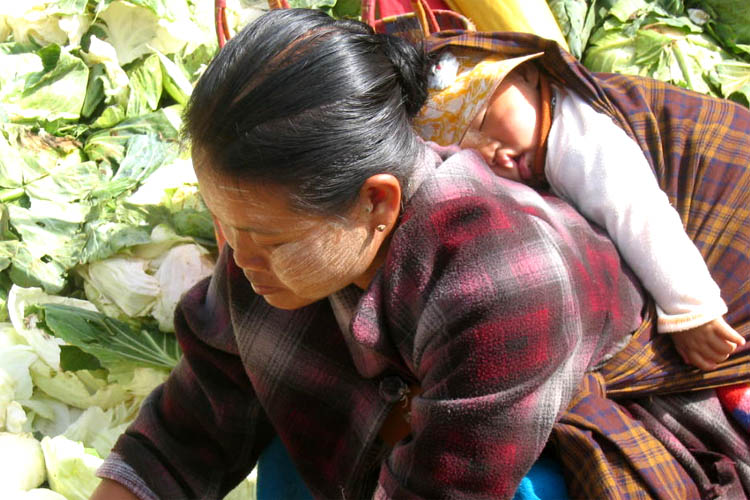
| and a mother carrying her child
|
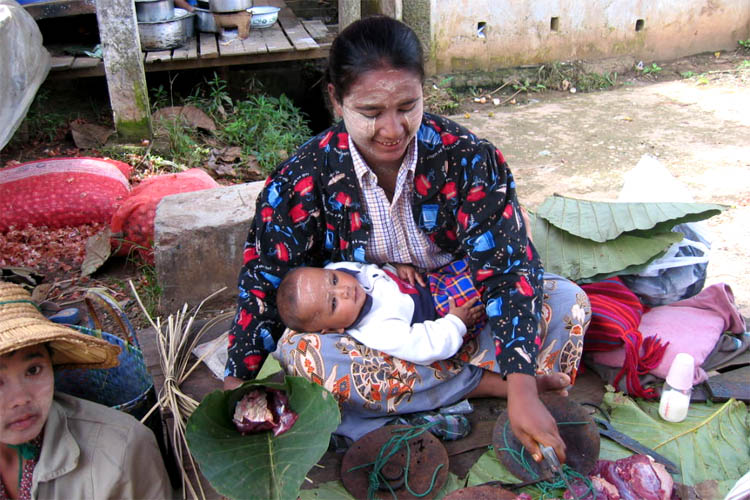
| Babies, babies, babies all around
|
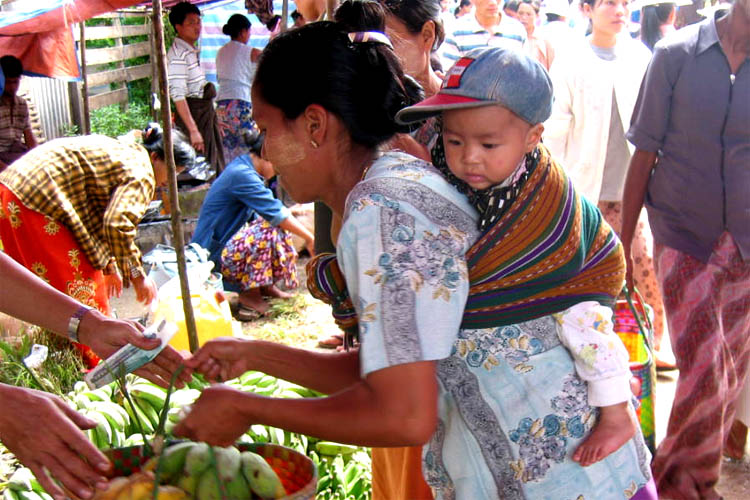
| The Burmese people will not soon die out
|
A lot of swastica signs we saw in temples and all around. This is not a Nazi stronghold here but religious people everywhere. It's a symbol of religious faith and the hook looks to the other side. Even though we saw a biker's steel helmet with that sign, looked like an SS-Stahlhelm, but was meant benign. But still, better having melons on the head.
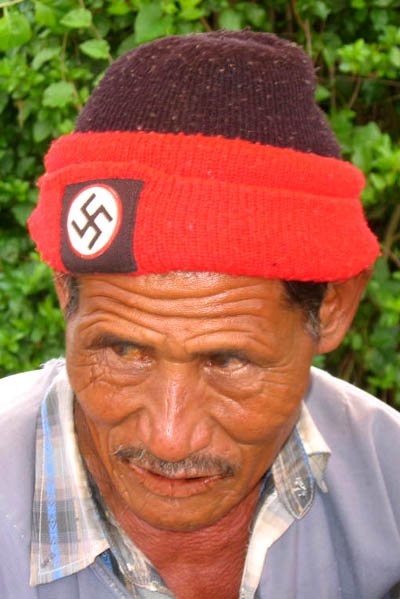
| It is not for sale, that cap
|
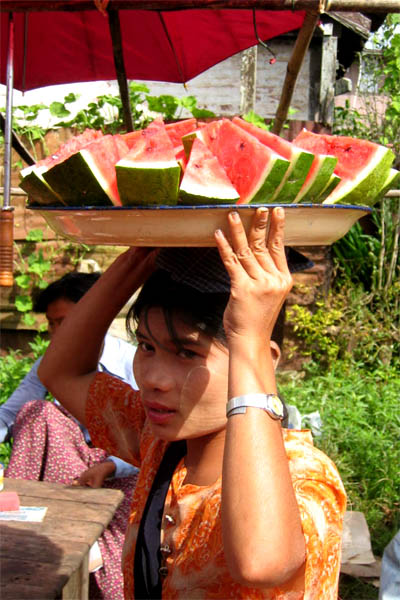
| but buy a piece of melon instead
|

| Not our taste, dried fish that smells
|
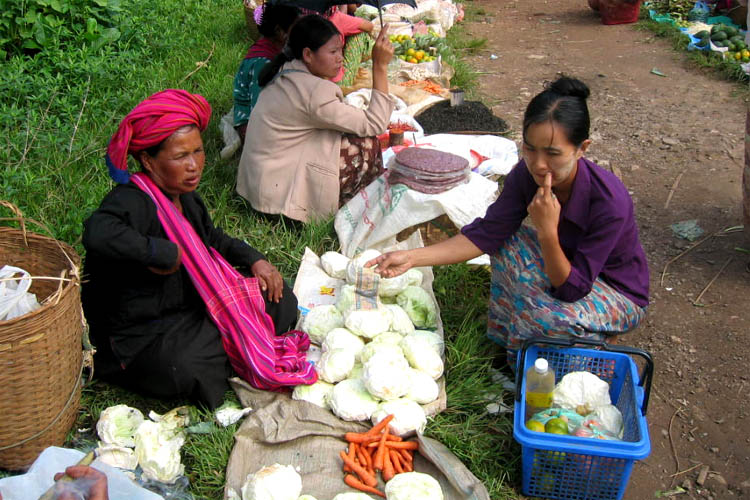
| but this is probably good for health
|
Trekking to the Hill Tribe Folks
And now some exercises are required: trekking up the hill to the hill tribe people, the Shan and the Palaung,
with our friendly guide
Jimmy Shwe
Tet Nay Win Tea Shop
Tel: 081-50401
|
who was recommended by our driver (one friend helps the other). I do not remember exactly how much we paid him, but it wasn't that much.
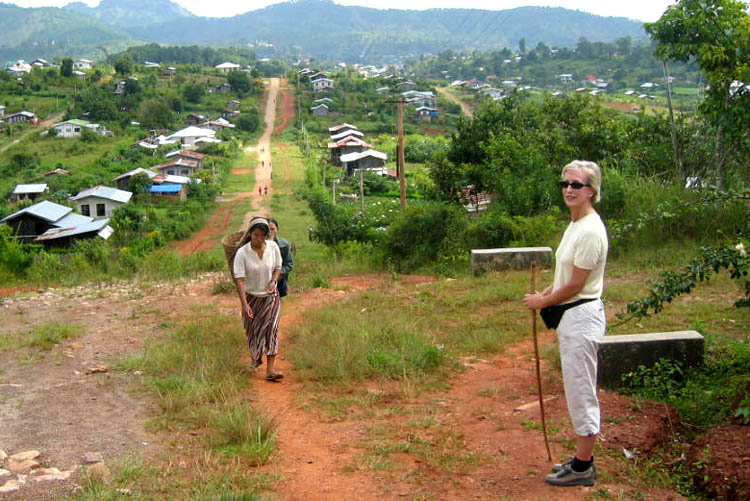
| Today is trekking day up the hill
|
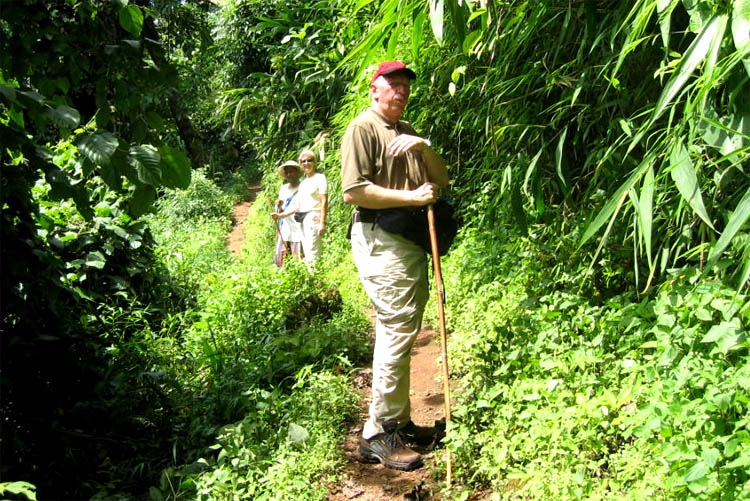
| to the hill billies, hopefully they won't kill
|
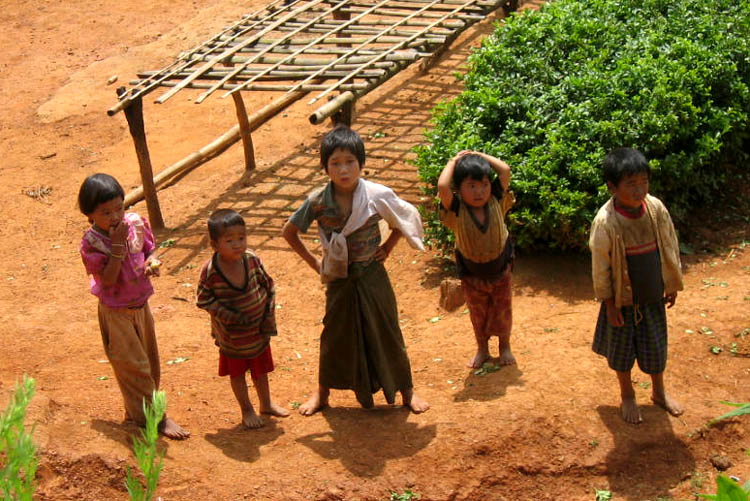
| A welcome committee saw us coming
|
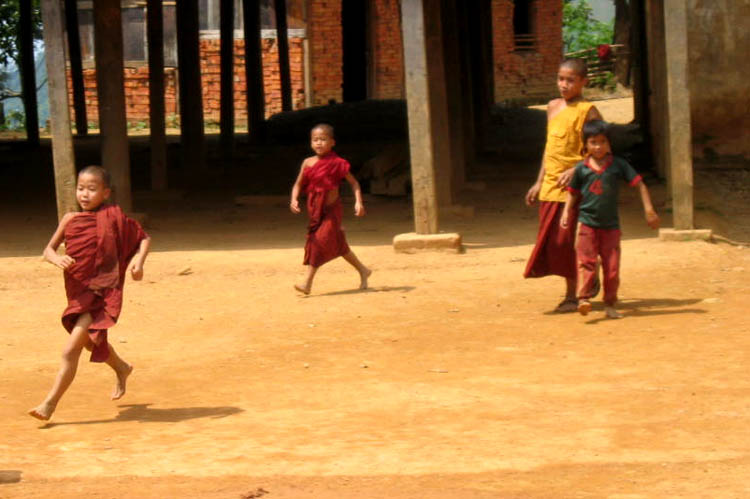
| and young Monks came running
|
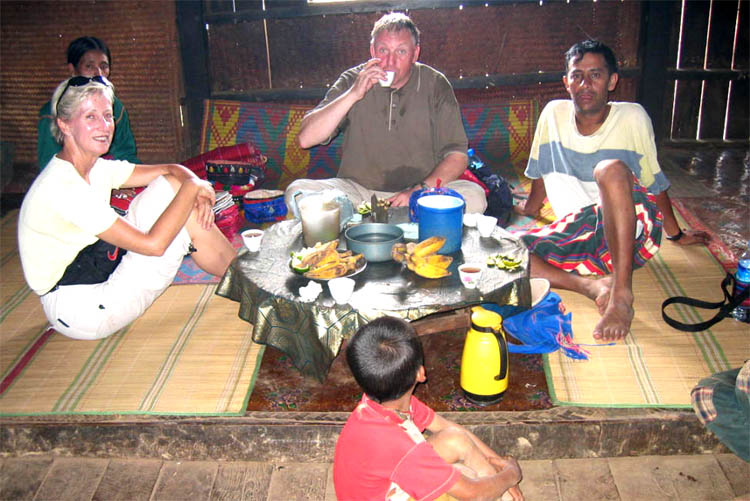
| Invitation to lunch with banana and tea
|
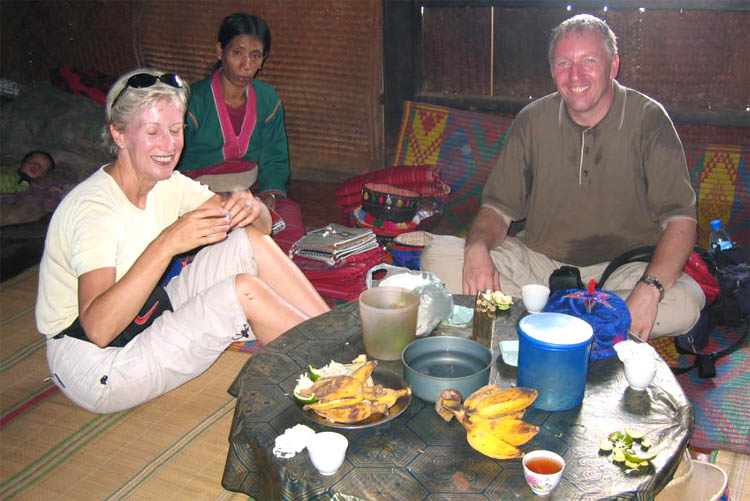
| very well arranged by our guide Jimmieee.
|
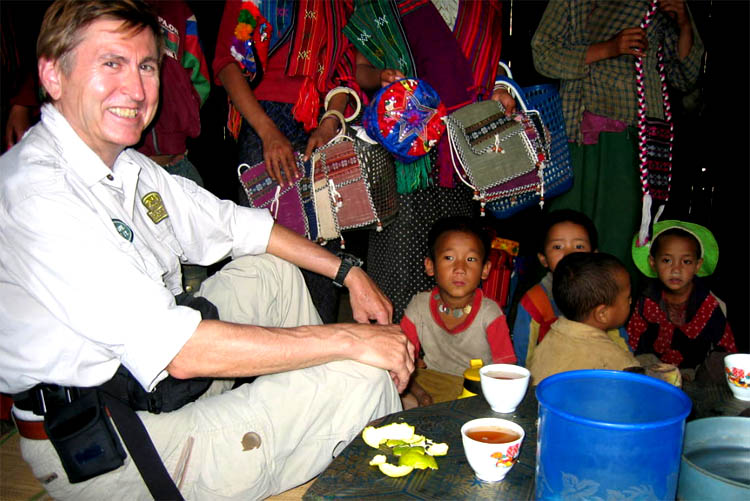
| Children were only looking, there was no "beg"
|
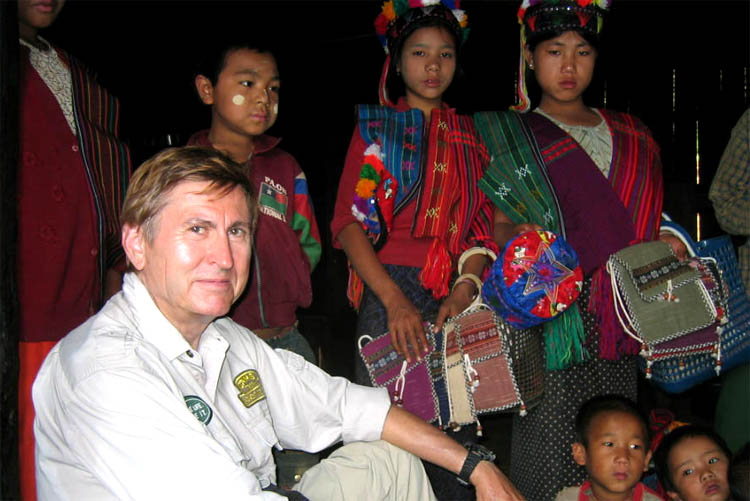
| Girls would be happy just to sell a bag.
|
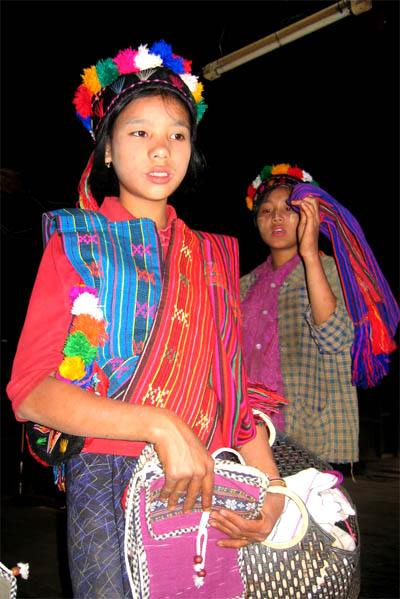
| Pretty girl better sells
|
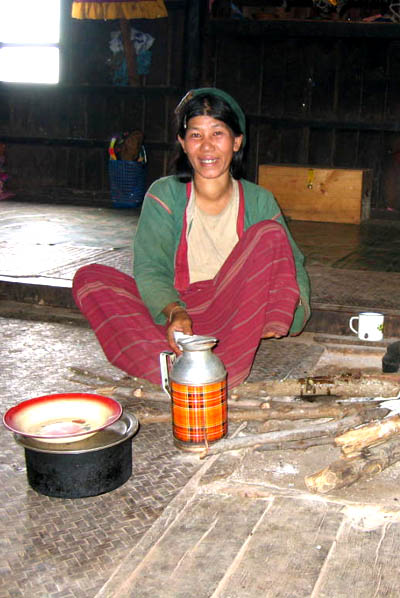
| Ugly lady better serves
|
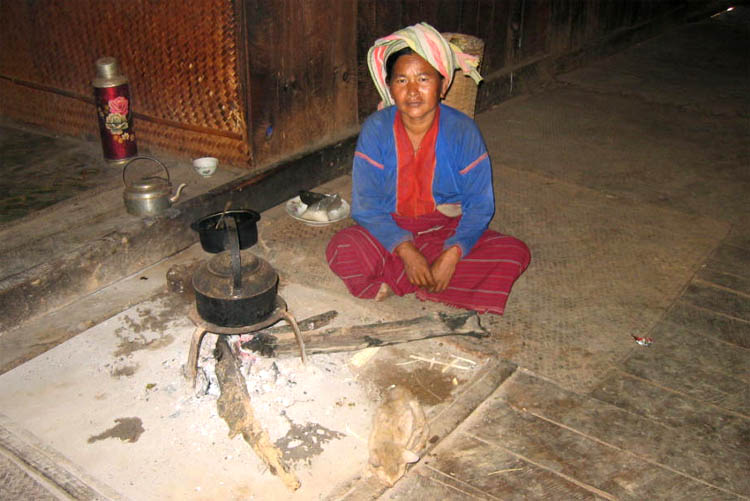
| Women are cooking
|
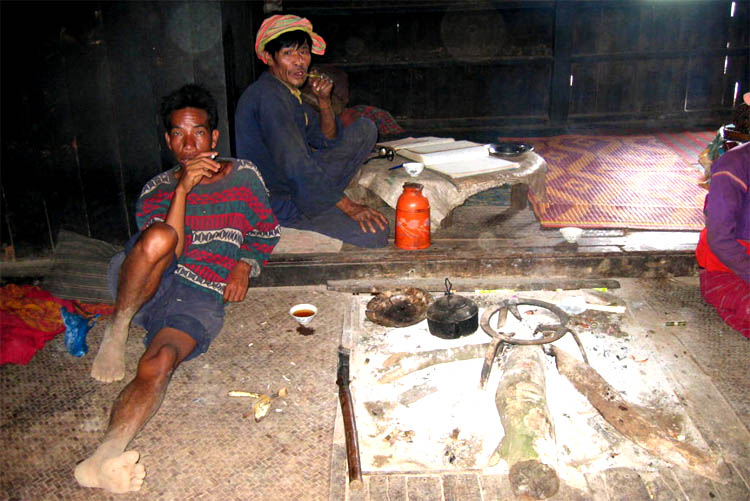
| Men are smoking
|
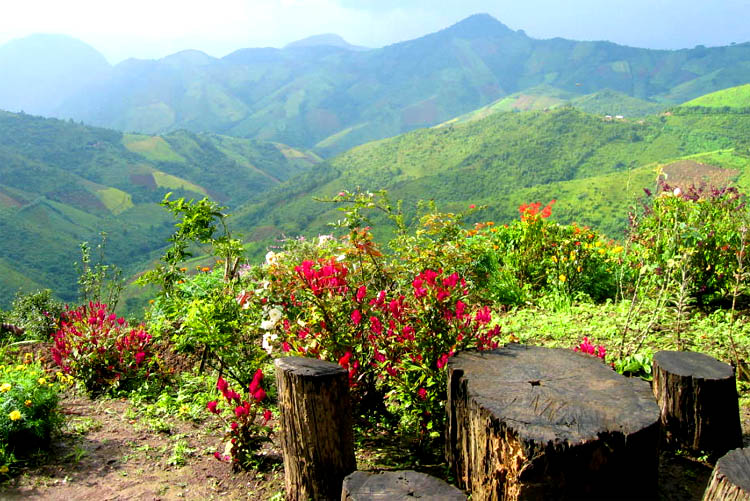
| From the smoky long house back to nature
|
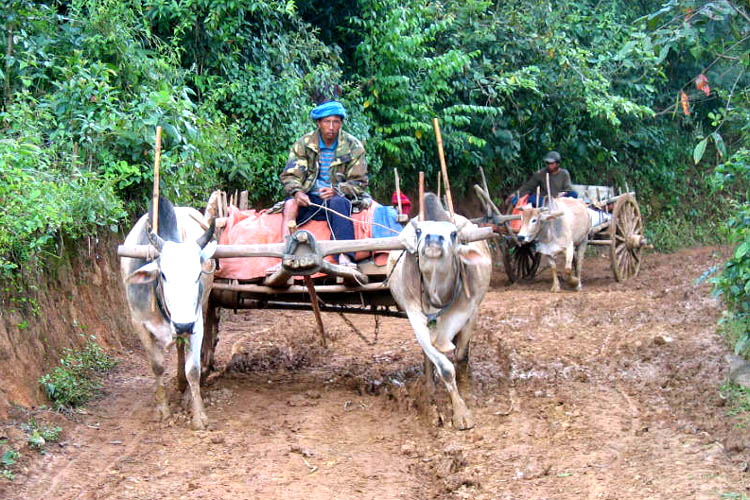
| and to the heavy traffic on the buffalo track
|
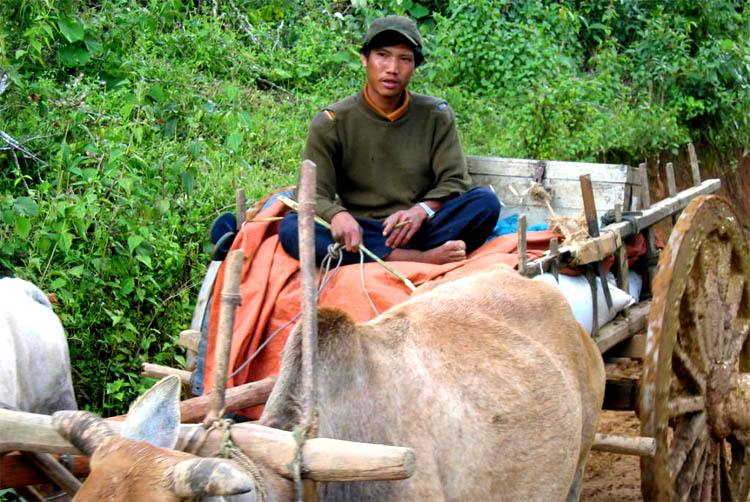
| Rider on an ox cart following the track
|
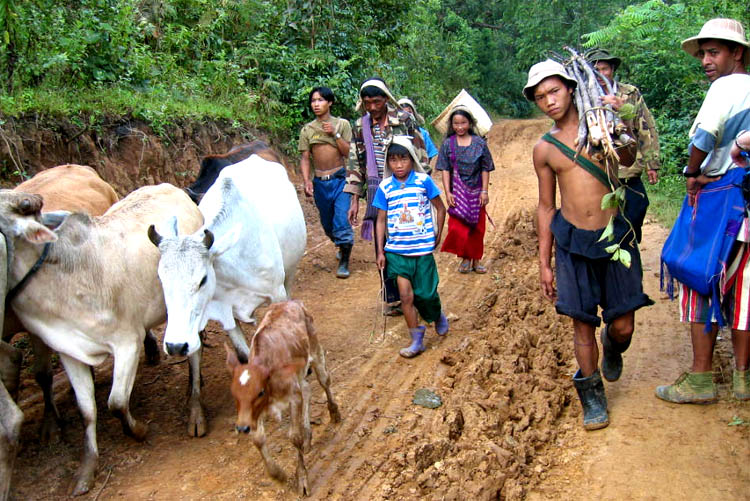
| Cattle and other folks follow behind in a trek
|
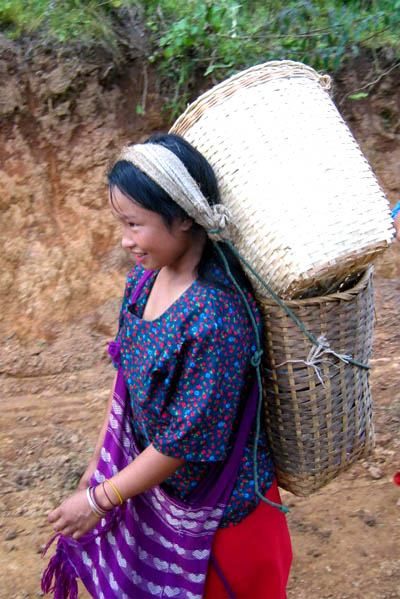
| That girl looks happy despite the load
|
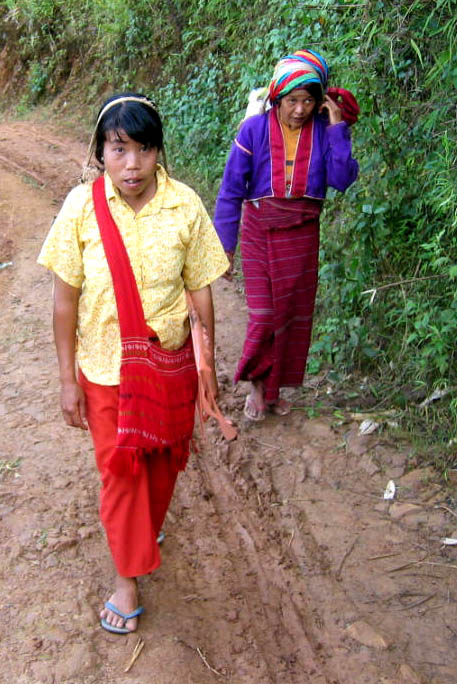
| Other women following the road
|
Visiting the Pindaya Cave
Then next day we went on the "Road to Mandalay", actually an old poem (Rudyard Kipling) and a new song now (Robbie Williams). On the way we visited Pindaya with its artificially walled-in Pindaya Lake and the famous caves. Most of the way to the cave we went up by car, skipping some of the roofed staircases and were even further relieved to find an elevator for the last 20 meters or so. The view from above was breathtaking, so was the cave itself: a huge labyrinth filled with the golden cave pagoda (Shwe U Min Pagoda) and all sorts of Buddhas made of bronze, marble or plaster plated with gold, up to 8000 of them with some meditation caves in between.
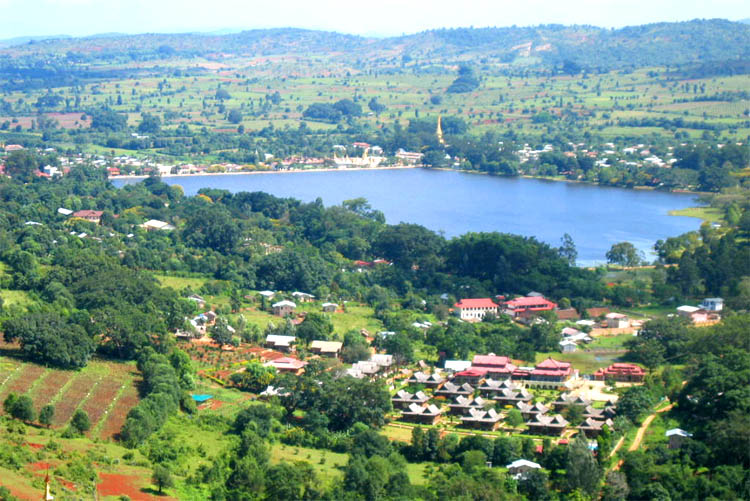
| Looking down to the Pindaya Lake
|
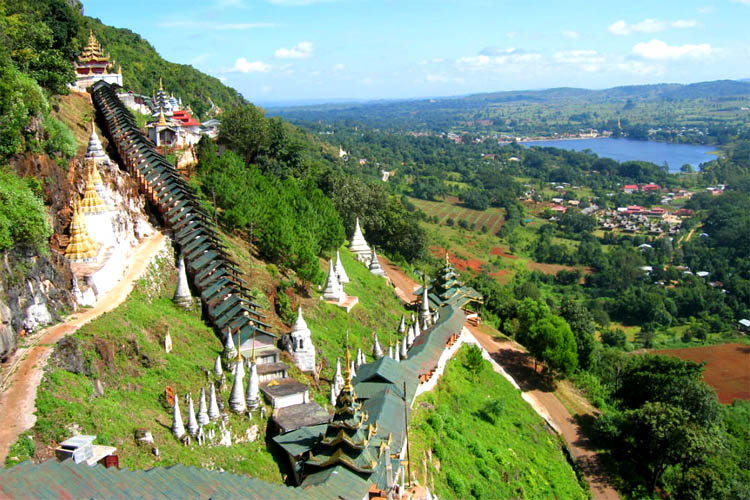
| and the staircases leading up to the cave
|
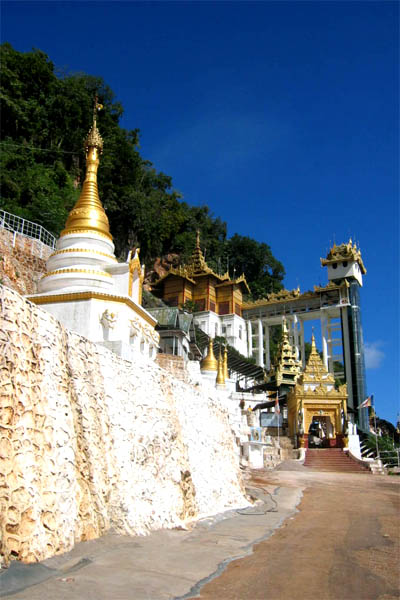
| Oh, an elevator for the tired one
|
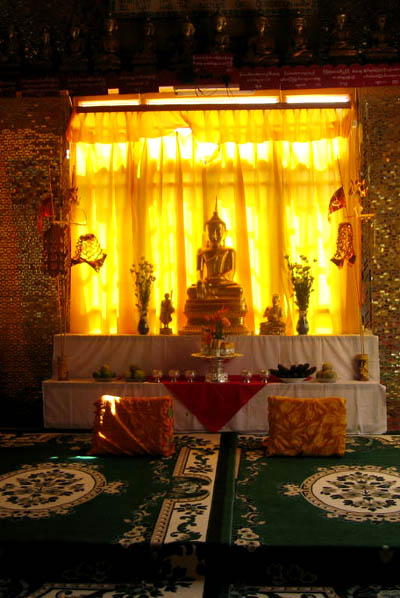
| Thanking good for the elevator
|
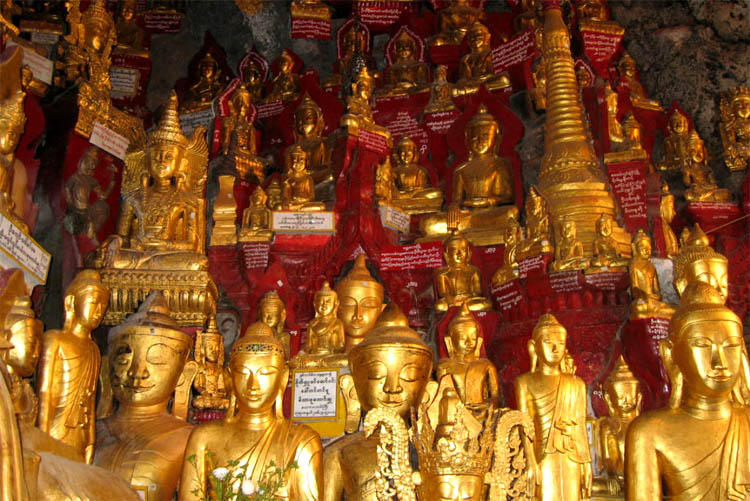
| Buddhas, Buddhas, Buddhas
|
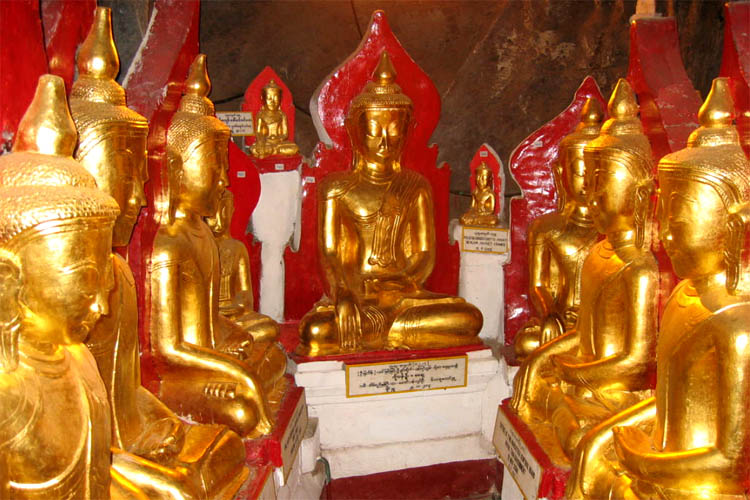
| All covered with Gold, Gold, Gold
|
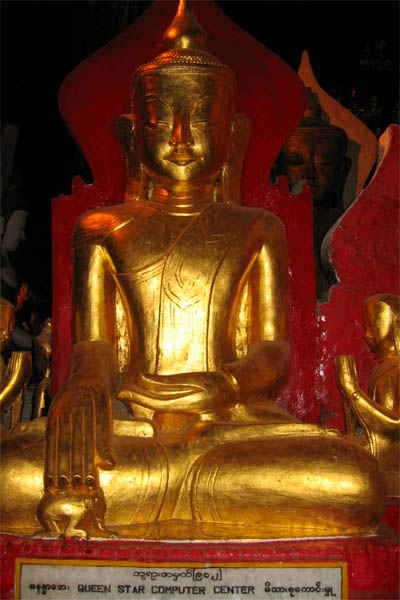
| Buddha sponsored by Queen Star Computer Center
|
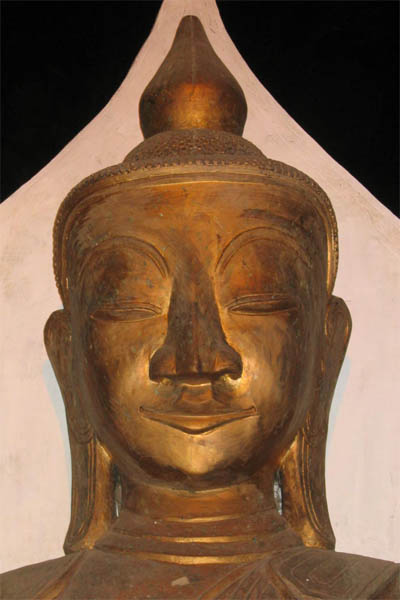
| Buddha I would like to take with me to my Computer Center
|
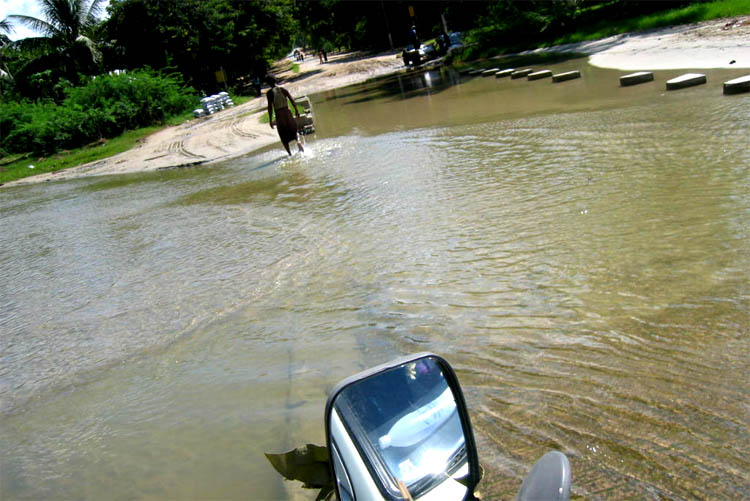
| Back to the road, or better crossing a river
|
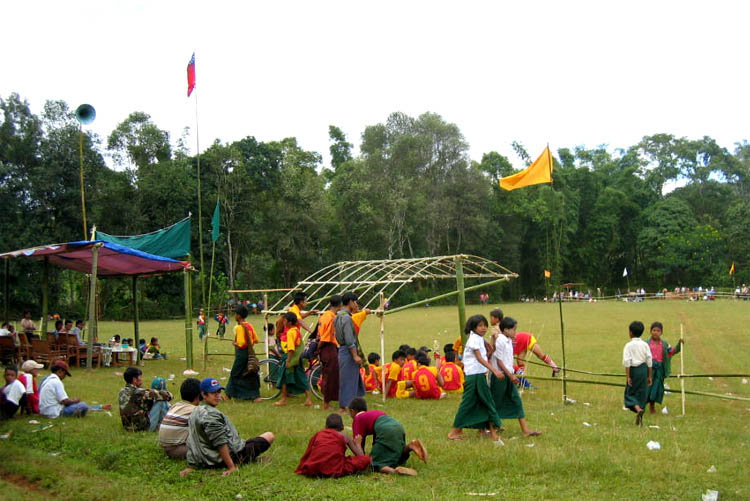
| Passing by a football game still going on
|
Arriving in Mandalay
And finally after a long drive on meandering roads (with river crossings) through the nice countryside we reached Mandalay, in th dark. The hotel recommended by the driver did not suit us, because we wanted something more luxurious, so we decided to stay in the
Mandalay Hill Resort Hotel
No. 9. Kwin 416 B
10th street
Mandalay
Tel(95) 235638
Email: mdyhill@mptmail.net.mm
www.mandalayhillresorthotel.com
|
but not for the official booking rate. After a long serious negotiation (Petra outdid me in that), we finally got a double room for 60 USD. It was a good deal for the former Novotel at the foot of the Mandalay Hill. It had all amenities of a 5 star hotel. The fantastic dinner buffet was worth the price of 29 USD each. The breakfast buffet came up to another 11 USD. Since our driver could sleep neither in his recommended hotel nor in this one, we gave him money for his own overnight stay.
Next day was due to climb the Mandalay Hill. Problem was that I wanted to get to the beginning of the roofed main staircase at the base of the Hill I remembered from my first visit in 1984, but was overruled by the rest believing more a local guy than me. So it turned out that we were walking up the road to the first landing (could have taken the car).
Unfortunately I lost all the photos of Mandalay somehow. But no big deal, I will show the old one some day. After climbing all the stairs we were rewarded with a beautiful view over Mandalay, beside that we will have a long life, as legend says who climbs Mandalay Hill.
Next, I suggested to visit the famous Mahamuni Pagoda, but I was overruled
again. The Zeygyo market, one of the biggest in Myanmar, proved to be a stronger magnet, especially for the ladies. At least I could have gone with Uli to the pagoda in
question, but eventually we both strolled around the market trying to find a decent
restaurant or cafe, while the ladies romped through the vast market, risking
death by falling down fan wings, which had hurt a young girl badly, according
to Petra.
After that we relaxed in the hotel at the nice swimming pool before we set out for our sumptuous dinner. So not much action in Mandalay, but who cares, we still had a wonderful day.
Visiting Mount Popa
From Mandalay we went first to Mount Popa, an extinct volcano rock, which we climbed under roofed staircases to the top to the ghost shrines of the Nats and the Buddha temples.
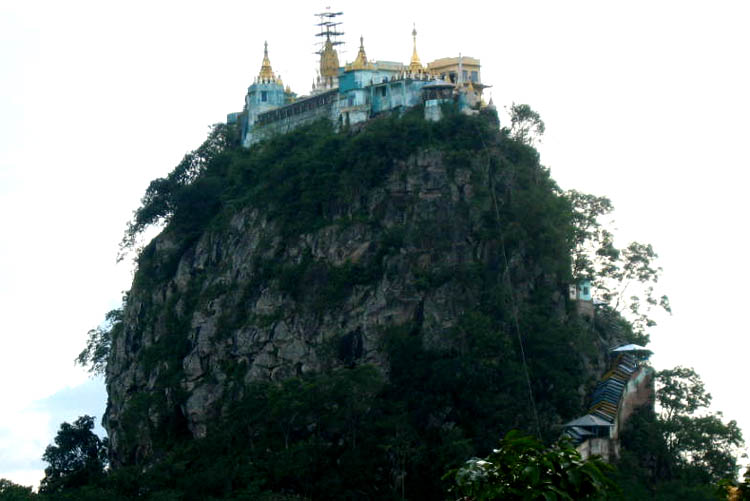
| This is Mount Popa with its temple
|
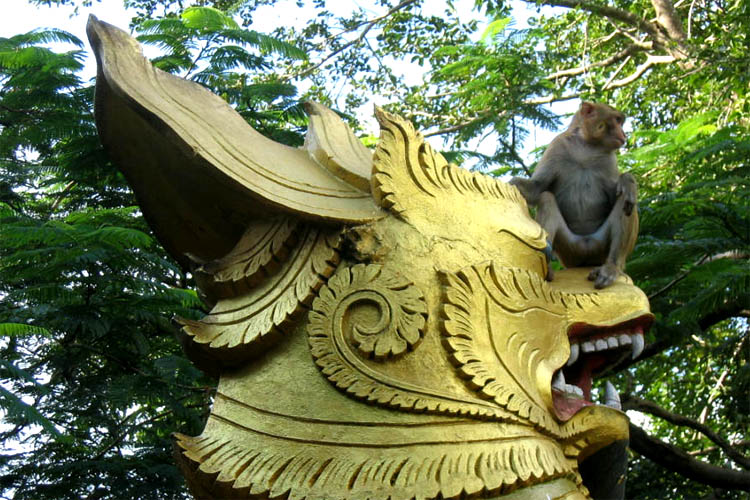
| to get up you have to pass the lion (and monkey) guard
|
Getting to Bagan
And now we are approaching Bagan, but before we could get close we had to pay the entrance fee at a road toll house, 20 USD each. What the heck, the first house again we will select, the
Bagan Thande Hotel
Tel:95 61 60025
Email: thande@myanmar.com.mm
www.asiamyanmarhotels.com/bagan/baganthande.html
|
The room rate for a double was reasonable (see internet site). Our room's window was facing the Ayeyarwady river, but we could not see much of it because we wanted to see as much as possible of Bagan during the day. We have already been rebuked by Uli that Brigitte (and me in tow) did turn up to late in the morning.
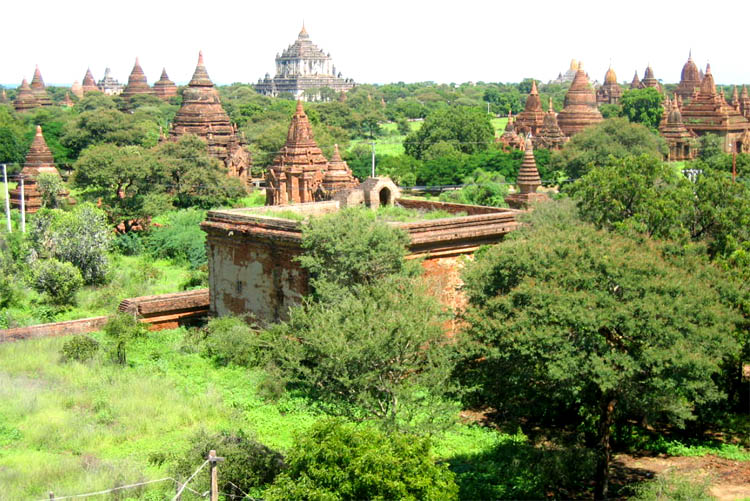
| Finally Bagan
|
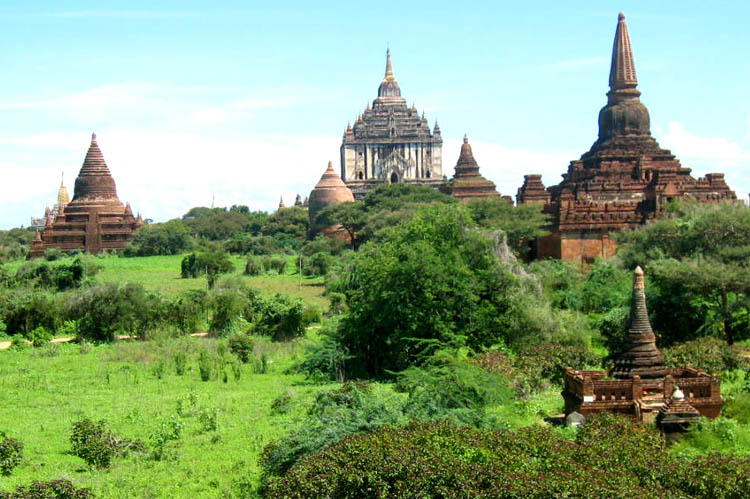
| with all its temples
|
What's better than walking is hiring a horse carriage for the day. Also our driver had a "friend" horse carriage driver, he recommended to us. The price was something around 1500 Kyats, thus 4 USD.
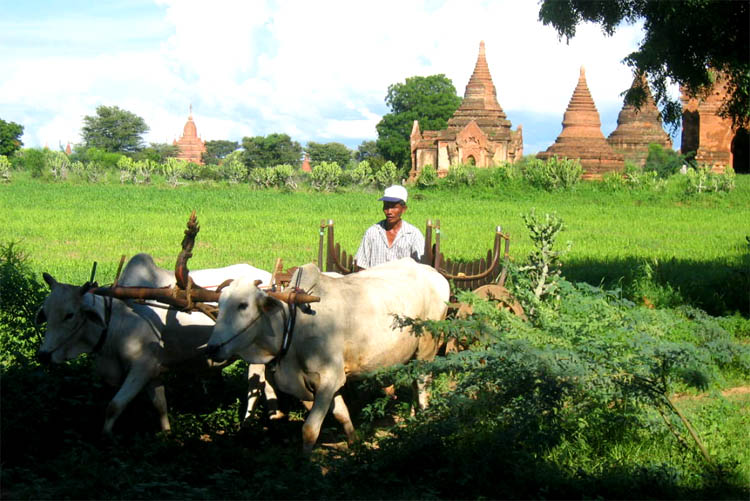
| Inconvenient to get around with an ox cart
|
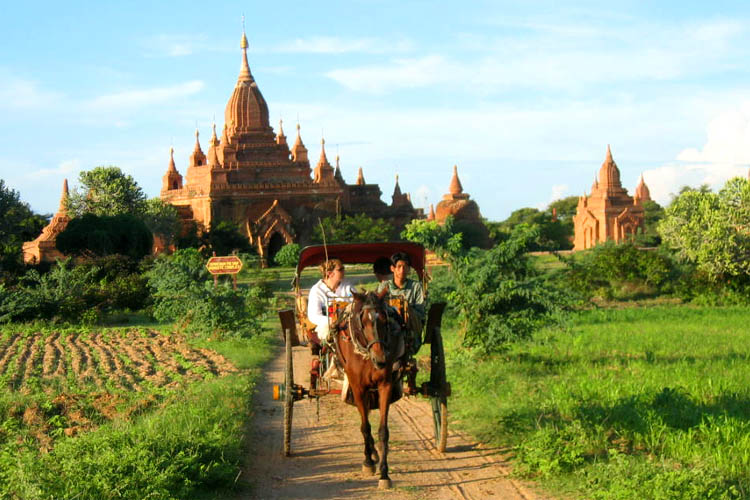
| but with a horse drawn carriage is a must
|
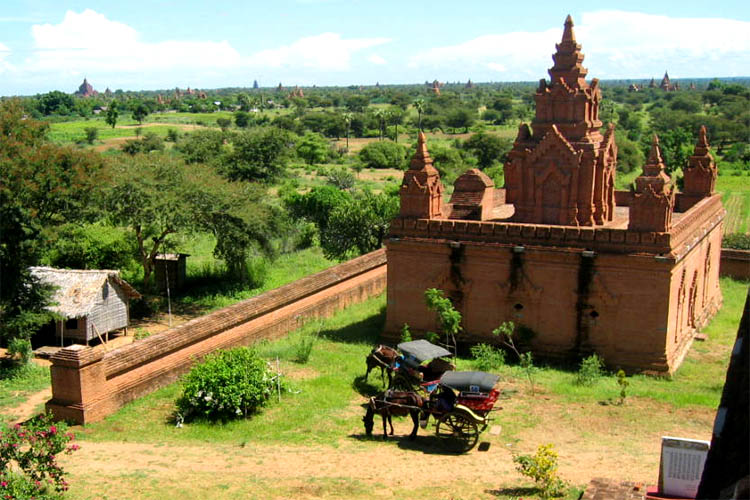
| The horses relax and we climb the temple
|
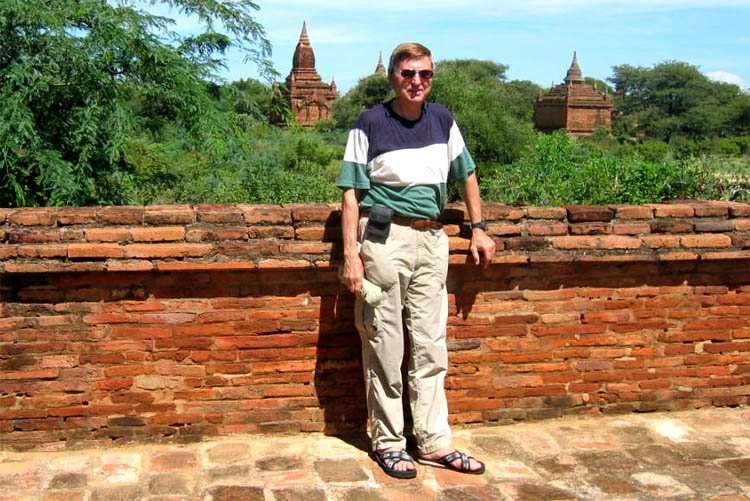
| having a nice view from the top
|
Bagan originally was a big city with around 20 000 temples scattered all around with the houses or dwellings for the inhabitants in between. It was destroyed in 1279 by Kublai Khan. Whatever was left was even more decaying especially the houses made of wood instead of stone as the temples of which now still 5000 are standing. Imagine Berlin destroyed completely (it almost was) except for all the churches and cathedrals (and maybe some government buildings, like the Reichstag?) with farmland in between now, it would look a little like Bagan today.
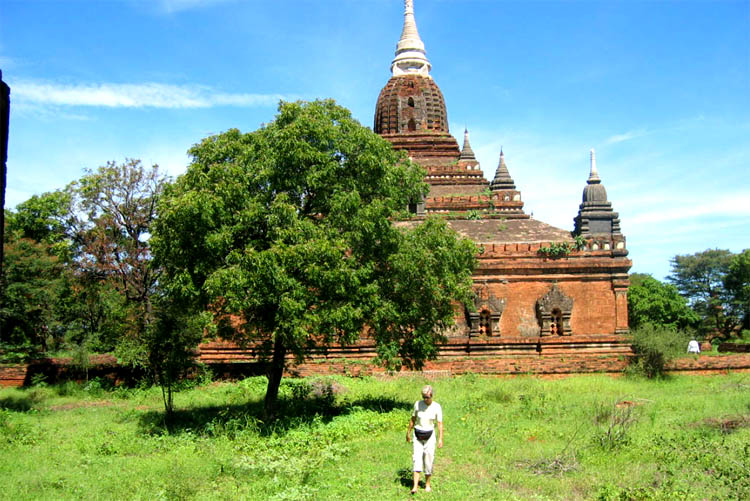
| Walking around between temples
|
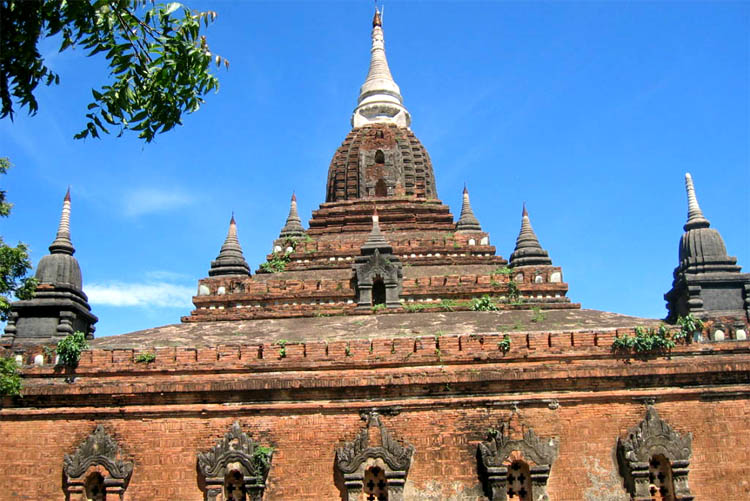
| and looking up at them in awe
|
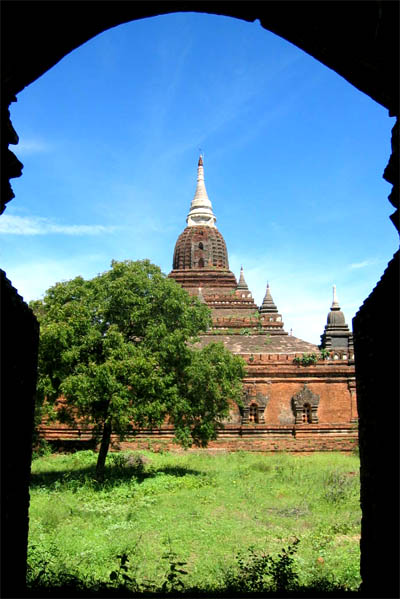
| Nice view looking also through
|
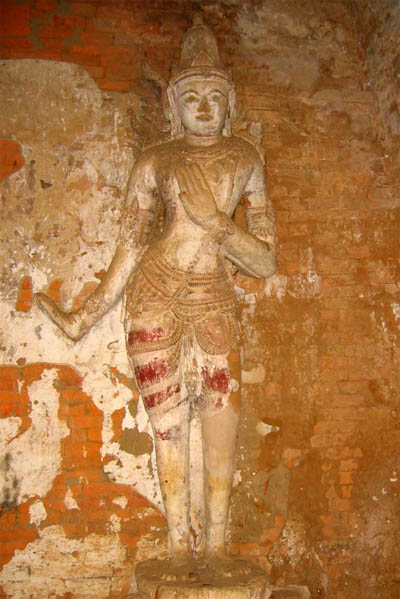
| and at the painting inside
|
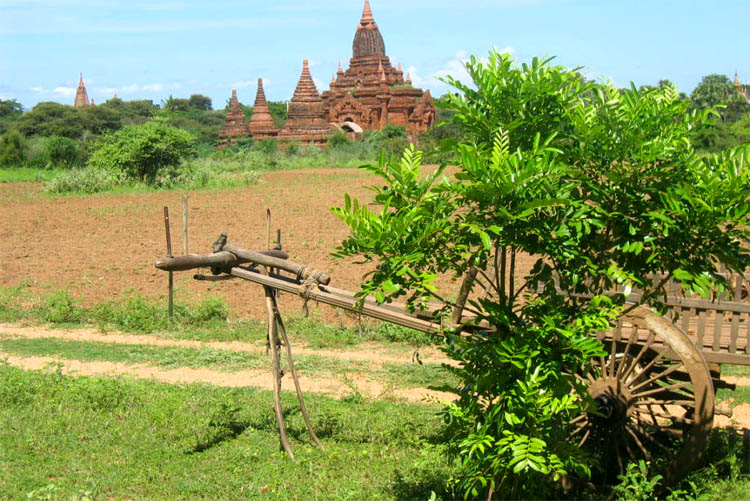
| Farmers still tending the fields in between some temples
|
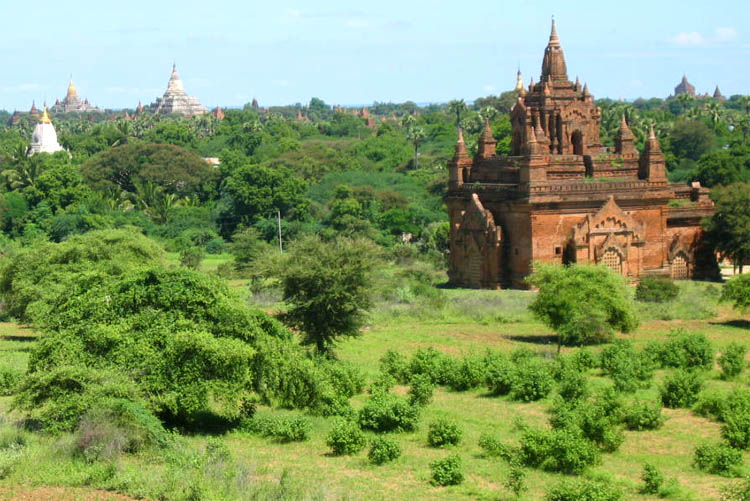
| Other temples seem to be standing in the wilderness
|
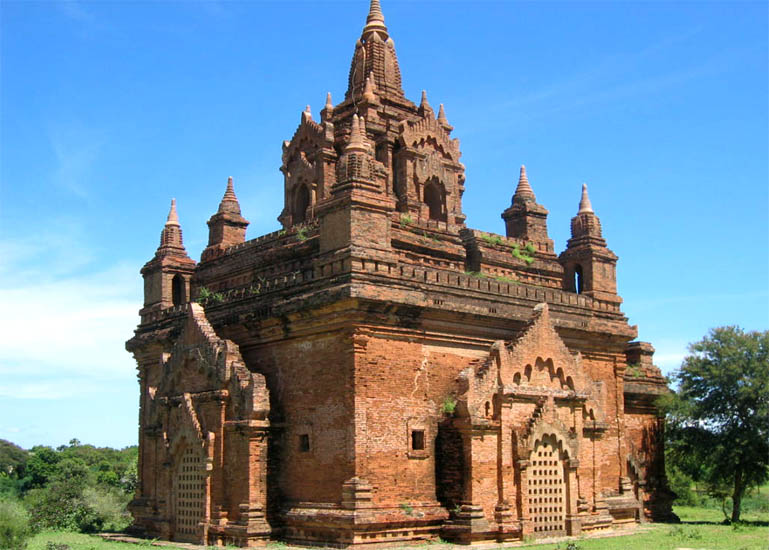
| One more temple to be climbed
|
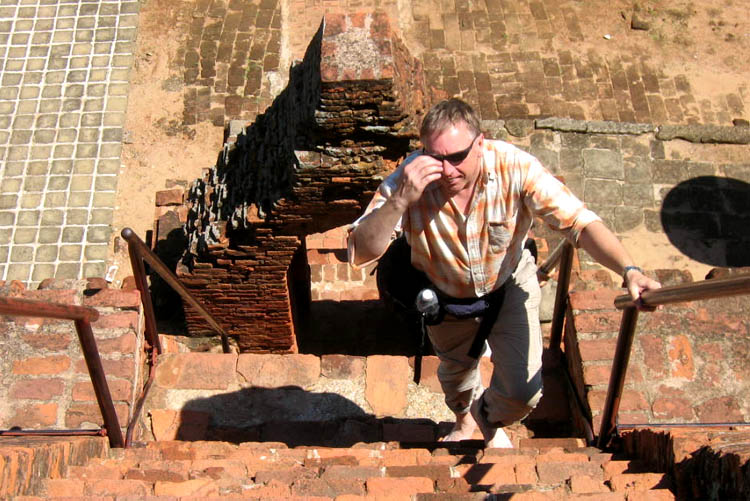
| and, Uli, not the last one, I remind
|
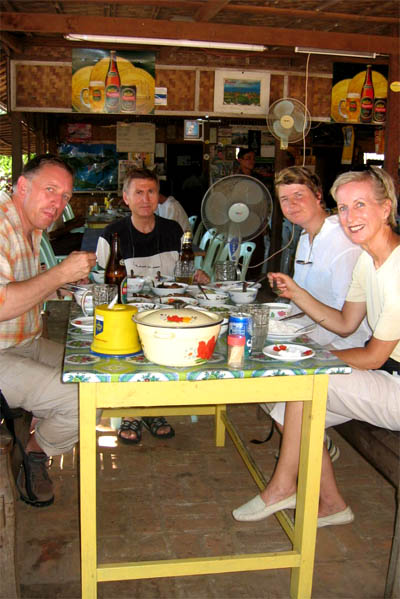
| Lunch has been really earned after sightseeing half day
|
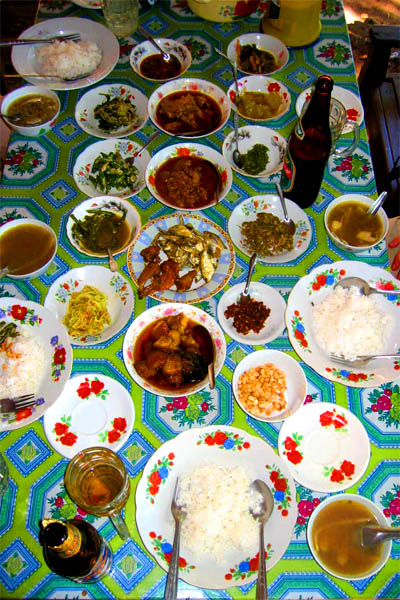
| That's all for us. More variety than quality
|
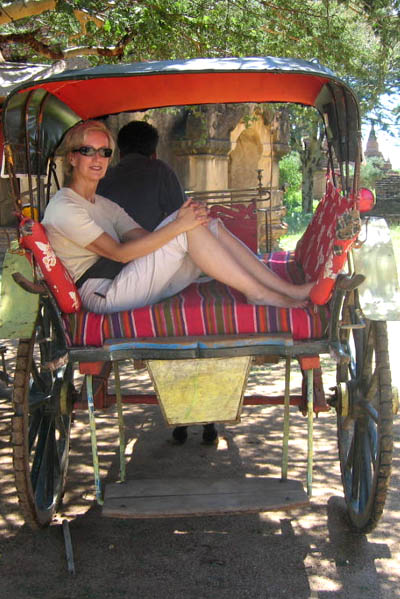
| An afternoon nap in the carriage was not possible
|
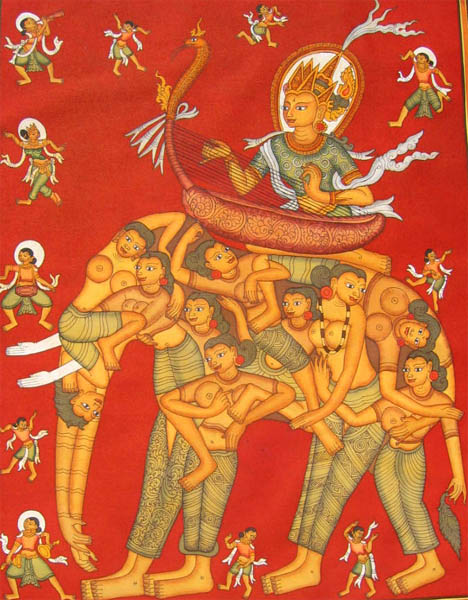
| But dreaming of an elephant made of bodies conceivable
|
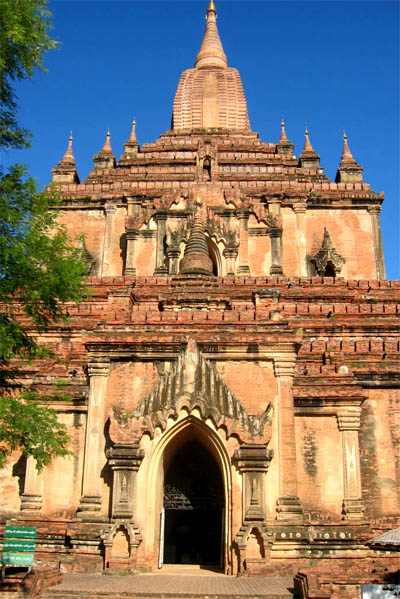
| More temples to visit are in sight
|
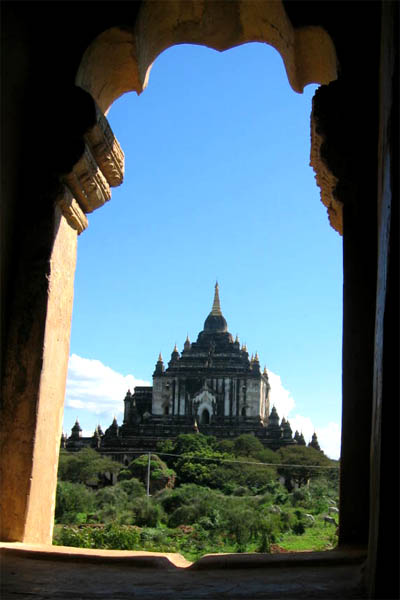
| The Thatbyinnyu Temple still far, right?
|
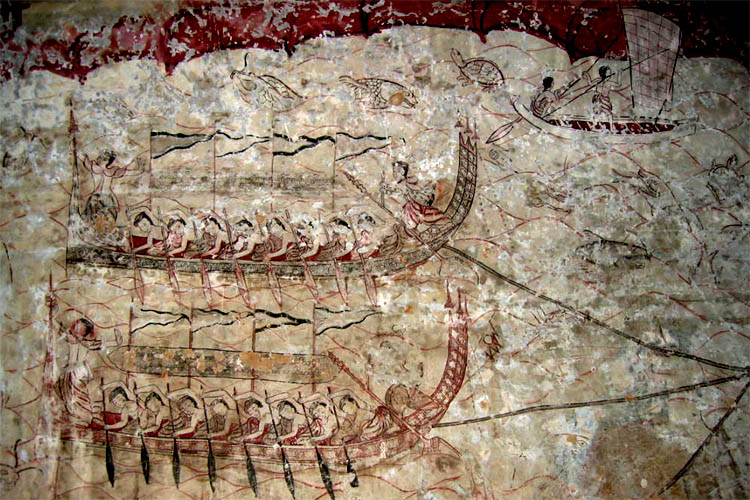
| Beautiful painting of a boat race inside
|
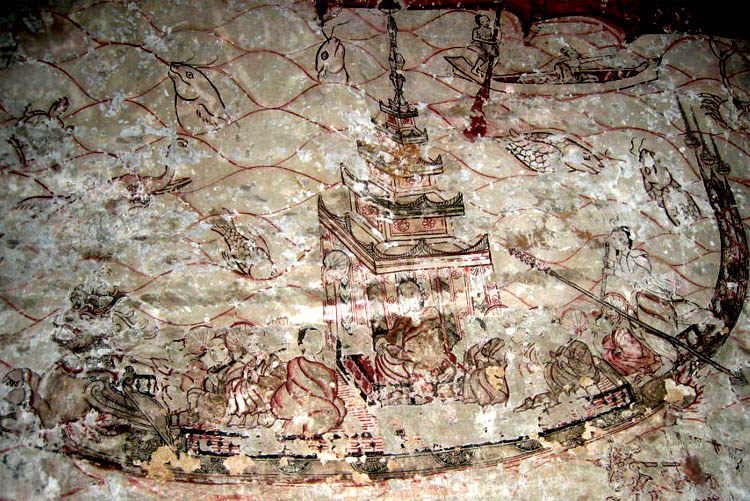
| and the king watching from his royal barge
|
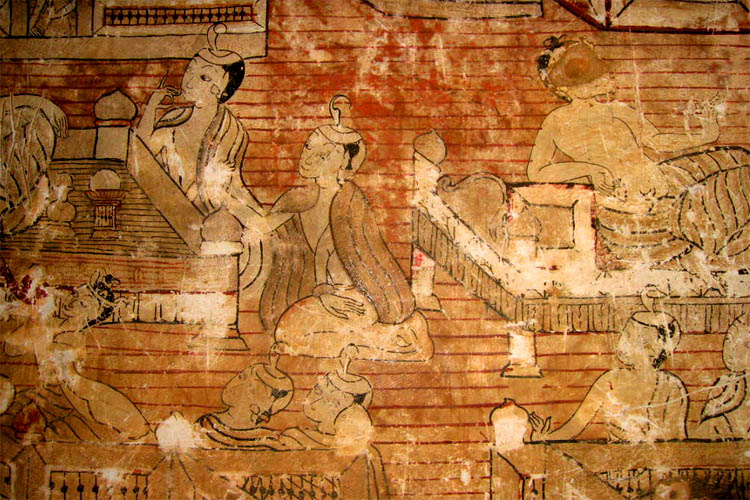
| What are two girls at each bed looking at?
|
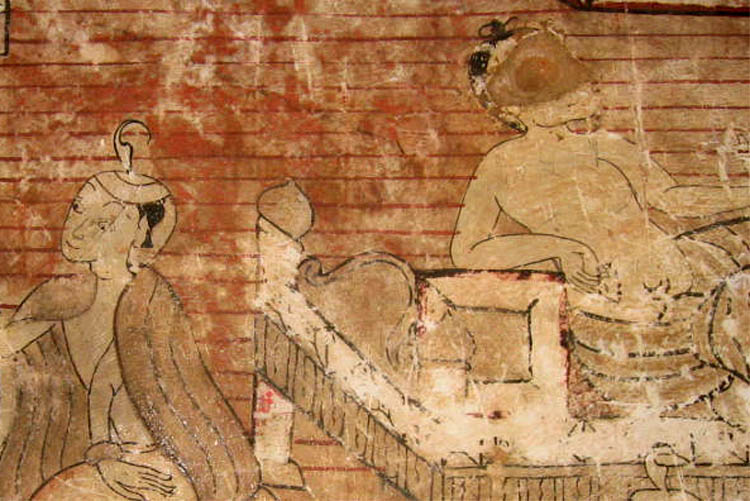
| Holy ghost, looks like temple prostitution?
|
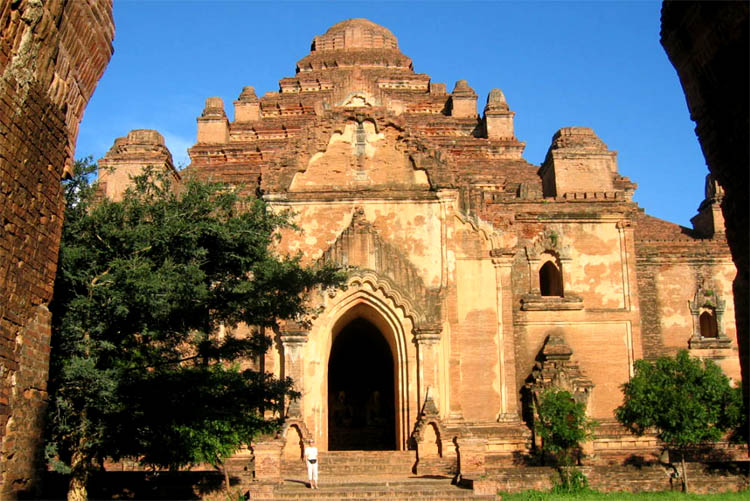
| With so many temples built, why not make one concession
|
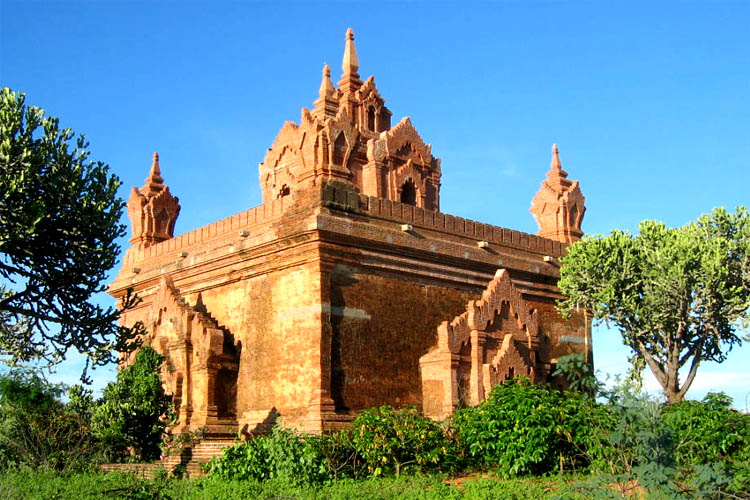
| to create one building for the world's oldest profession
|
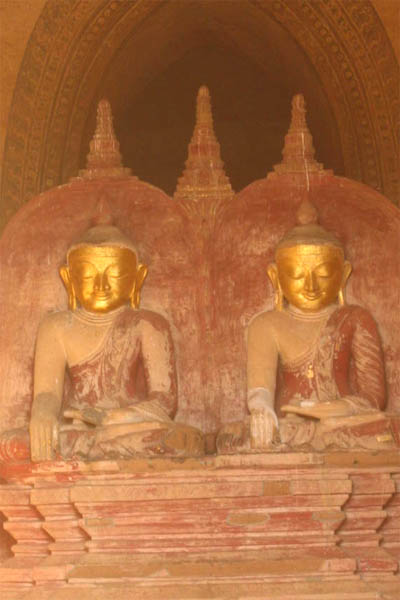
| Two Buddhas nice to look at, right?
|
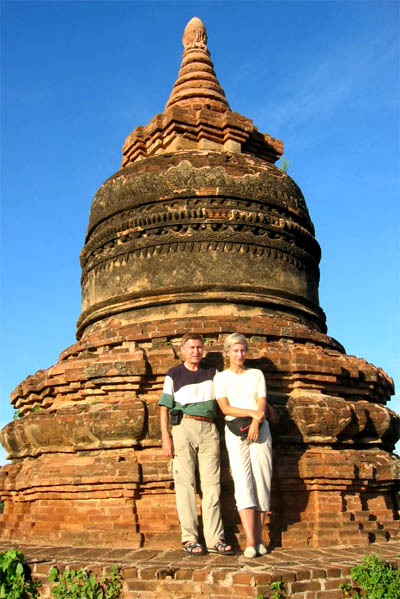
| A tourist couple spoiling the stupa sight
|
Now we are closing in to the famous Ananda Temple as a highlight and for the sunset watching later on. It is one of the four main temples remaining in Bagan and is considered to be one of the most surviving masterpieces of the Mon architecture. It is said to have been built around the year 1105.
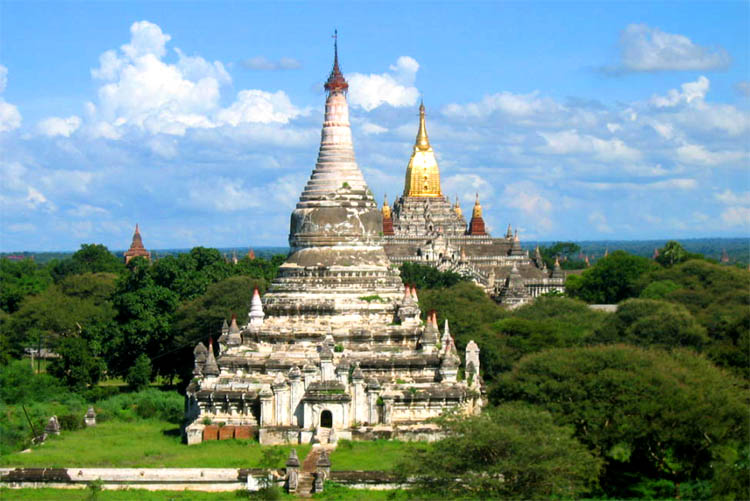
| And finally the Ananda Temple is in sight
|
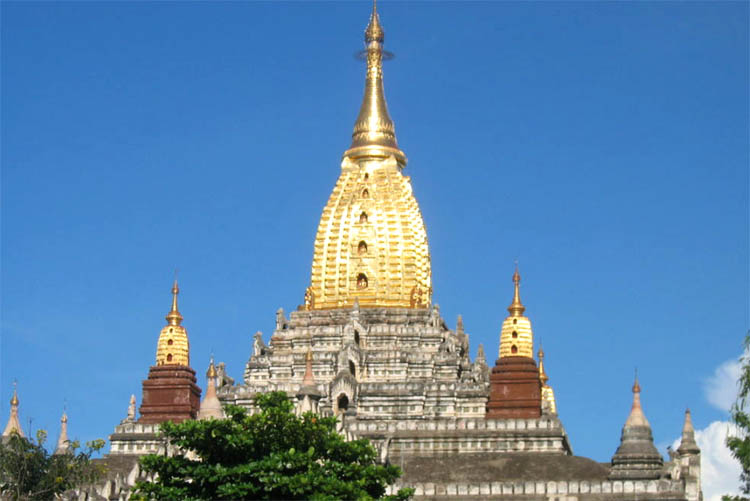
| this is the most beautiful one, right?
|
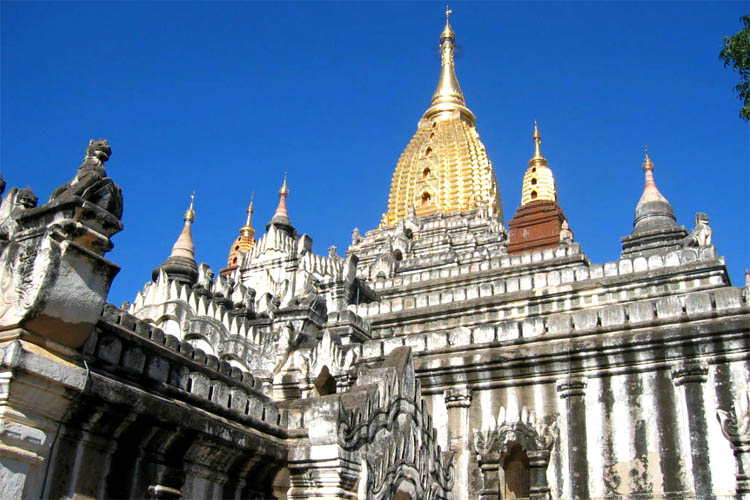
| Looking up, It still looks almost new
|
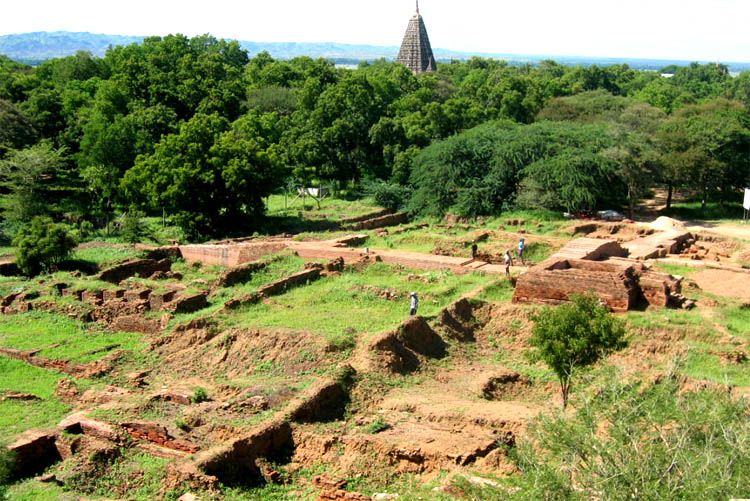
| Looking down, this has crumbled long time ago
|
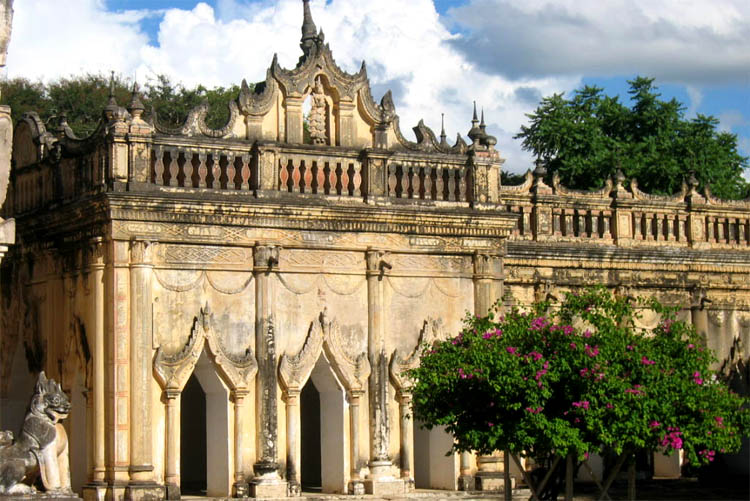
| Could be almost a palace
|
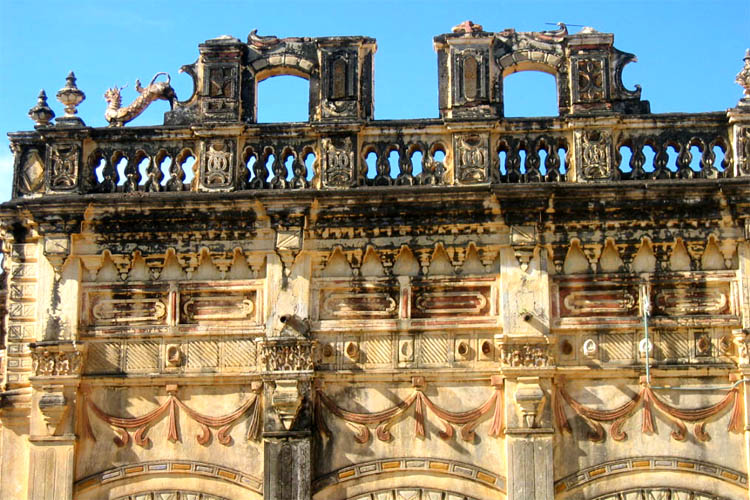
| and up there with a nice terrace
|
And now the sun is setting slowly and we are looking around from the top of the Ananda Temple trying to get a last glimpse of the splendor despite the crowd also compiling for that last moment, which is also quiet and contemplating.
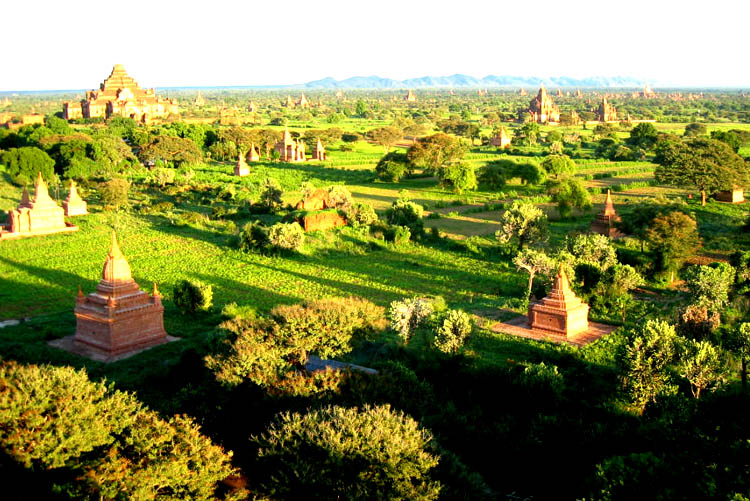
| Sun is setting slowly and
|
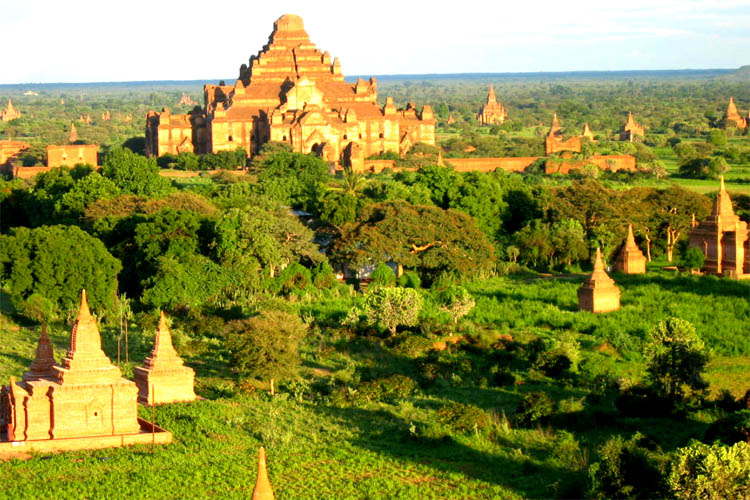
| the shadows are getting longer
|
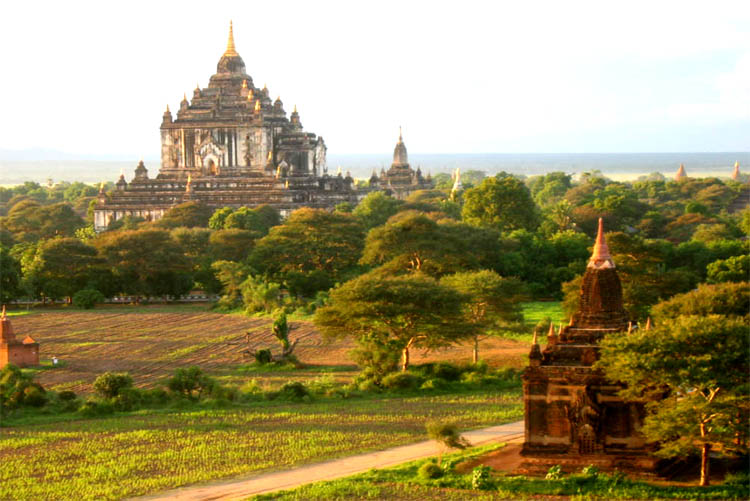
| The Thatbyinnyu Temple standing in front
|
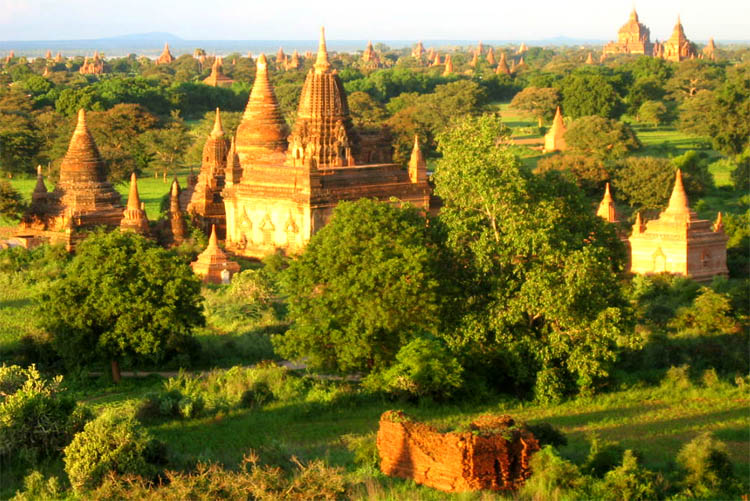
| and more temples emerging far away
|
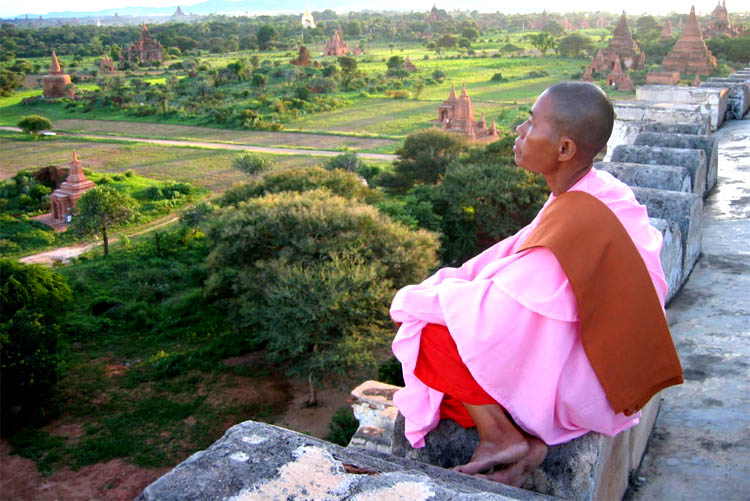
| All this is being watched during the sun set
|
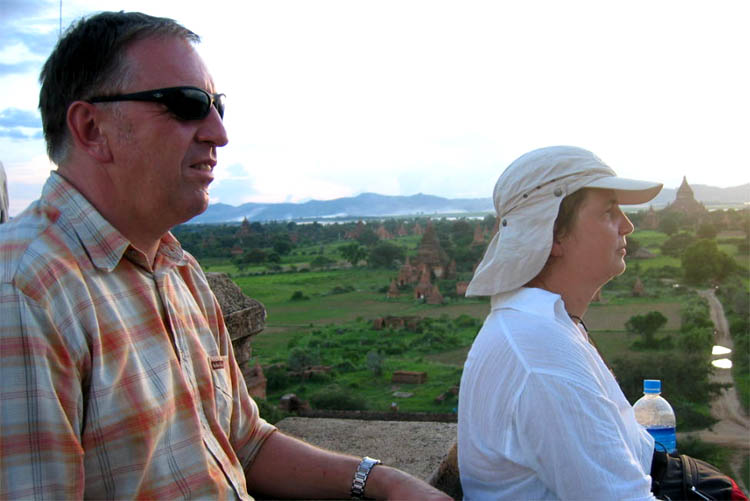
| from above the majestic Ananda Temple
|
Going to Pyay
On the road again next day, driving almost all day, making a break here and there, visiting a distillery on our way, for tasting we were too shy,
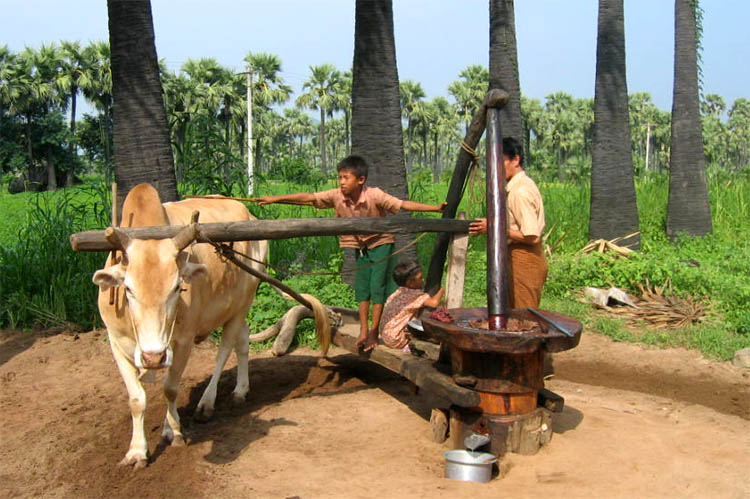
| An ox going in circles while getting dizzy
|
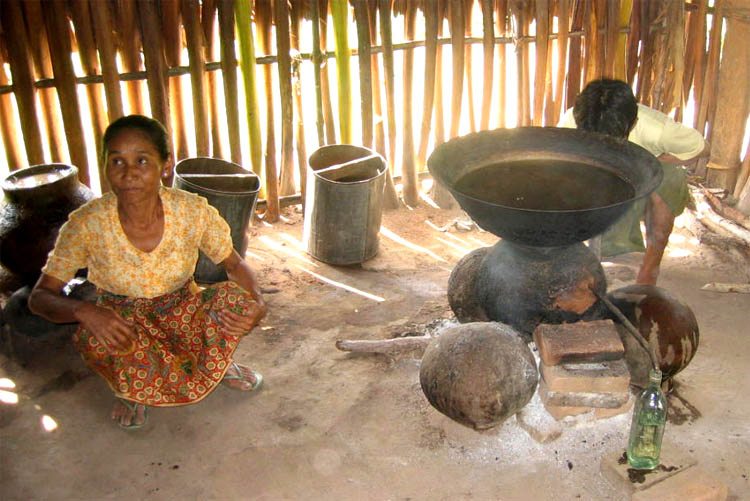
| all for making sugar liquor to get tipsy
|
until we reached Pyay (or the old Prome). where we will stay, by the way, at the
Mingala Garden Resort
Aung Chan Tha Quarter
Flying Tiger Garden
Tel: (053)21018/22179
|
The room rate for the double was 36 F.E. (Foreign Exchange Certificate), according to the bill. Couldn't understand the rest of the bill, all was written in Burmese script anyway.
The amount was the equivalent of the same in USD.
From here it is possible to go by car or bus to Ngapali beach, time permitting, and it is really a rough long ride through the country side, I was told (usually flying from Yangoon is the better choice, still).
Next morning we finally continued on our last leg to Yangoon.
Back in Yangoon
We arrived by noon in Yangoon and settled down at the "Yoma" again. We paid our driver including a generous tip and then we went off to see the famous Shwedagon Pagoda.
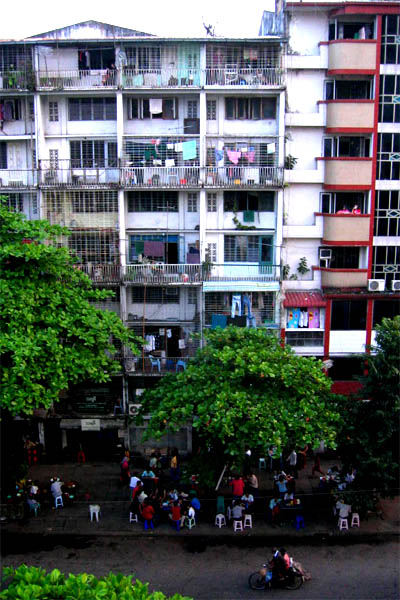
| Looking out from the "Yoma" to the street
|
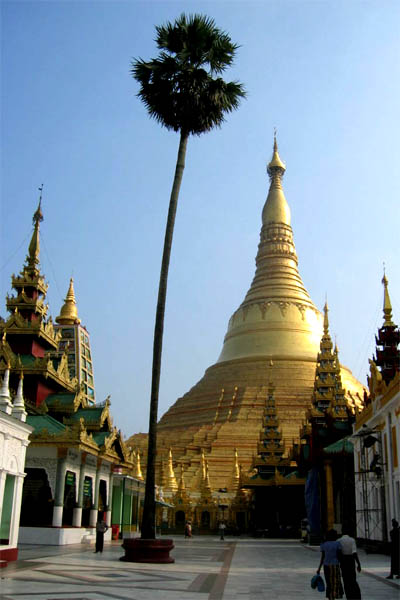
| Better look up to the famous Shwedagon Pagoda
|
The Shwedagon Pagoda is impressive. With 107 meters it is not as high as the Shwemawdaw Pagoda in Bago with 115 meters, but it outdoes everything with other features like 80 tons of gold, 1090 diamonds, 1338 sapphires and rubies. The top, the so-called flower bud consists of another 4330 diamonds topped with a 76 carat diamond (and Myanmar is one of the poorest countries in the world). Maybe they use our entrance fee of 5 USD to put more gold on the pagoda.
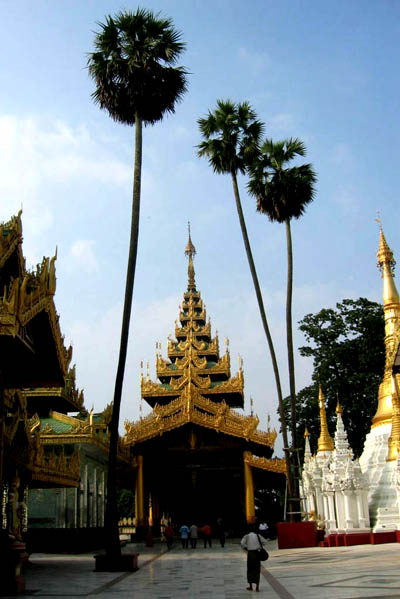
| What a nice temple area
|
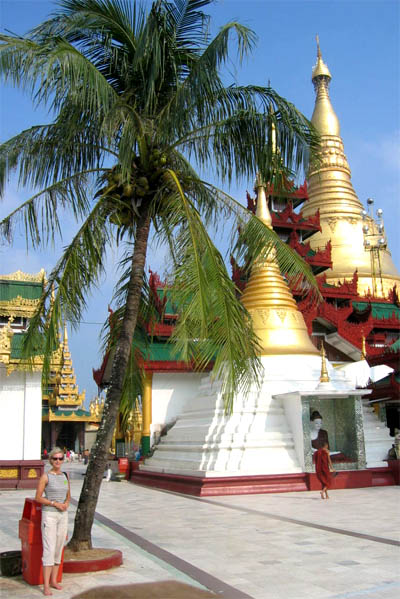
| to stroll around
|
The stupa's circumference of the octagonal base measures 500 meters and is surrounded by 4 larger stupas and 64 smaller ones.
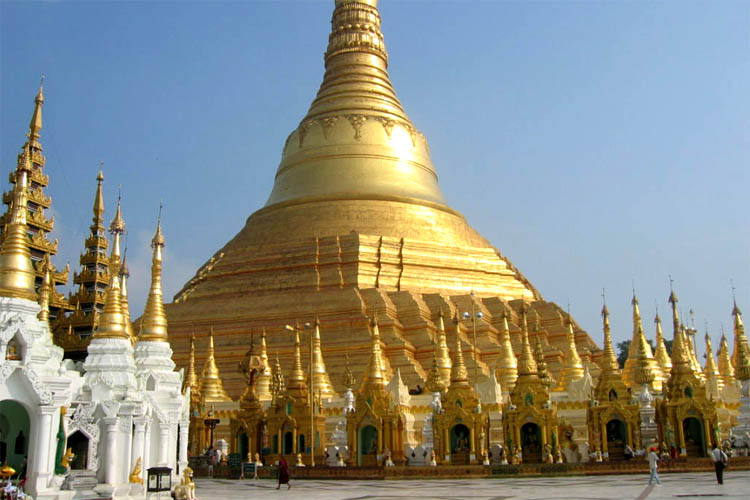
| The big eyes are getting small
|
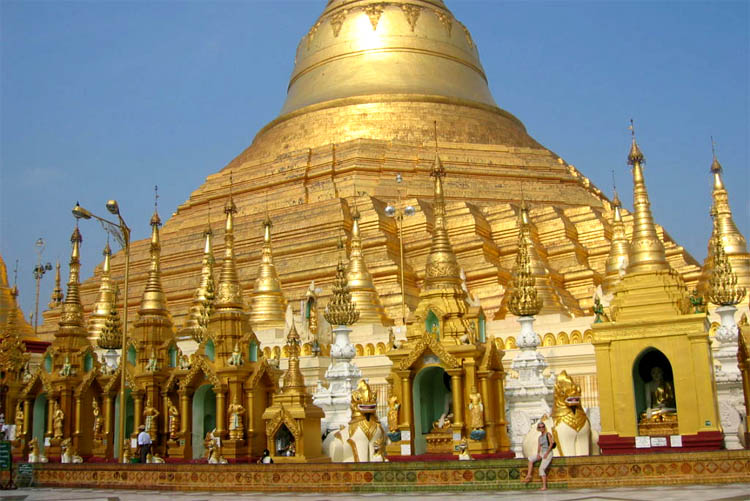
| in the glaring gold and sun light
|
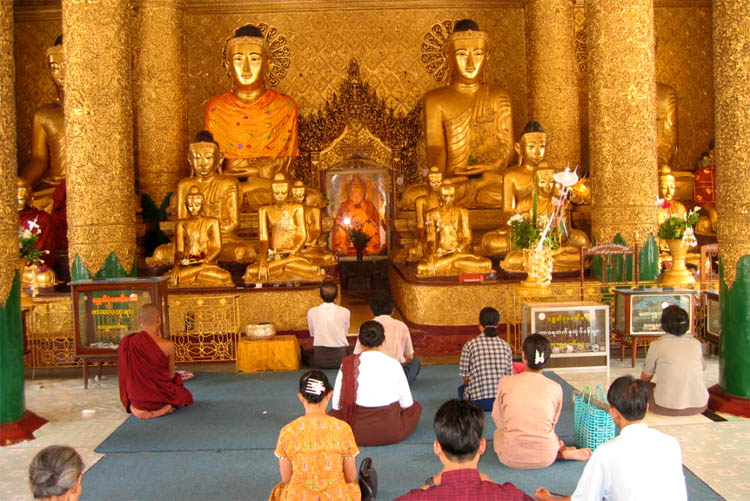
| Sitting worshippers before two sitting Buddhas
|
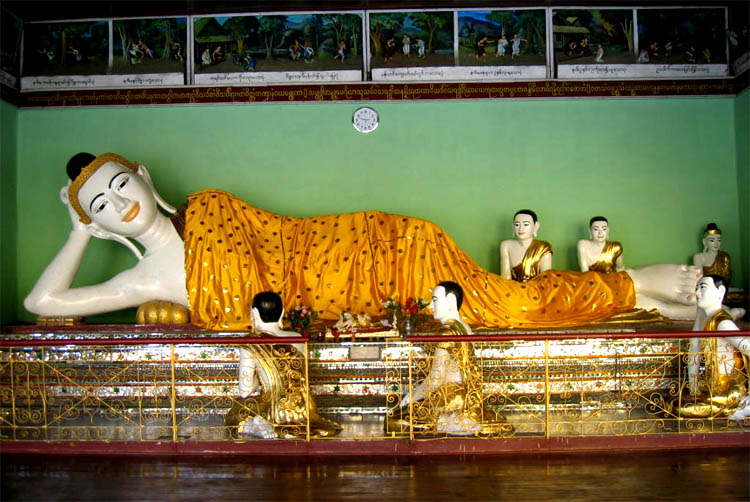
| and a lying Buddha, oh no, one of the reclining Buddhas
|
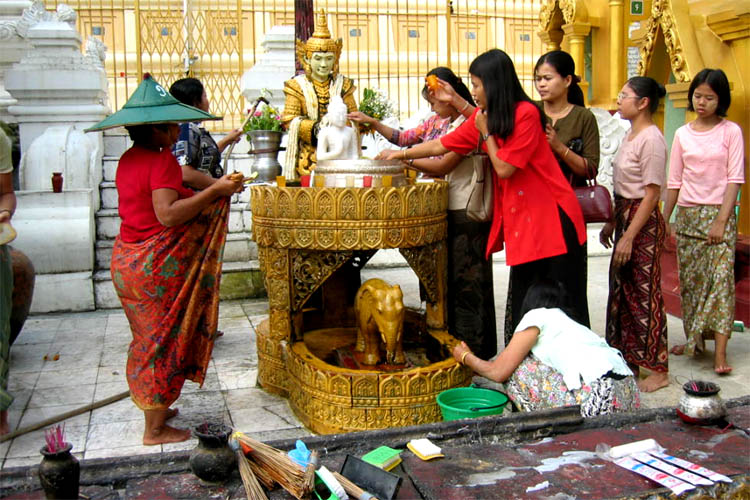
| People bringing offerings to the holy shrine
|
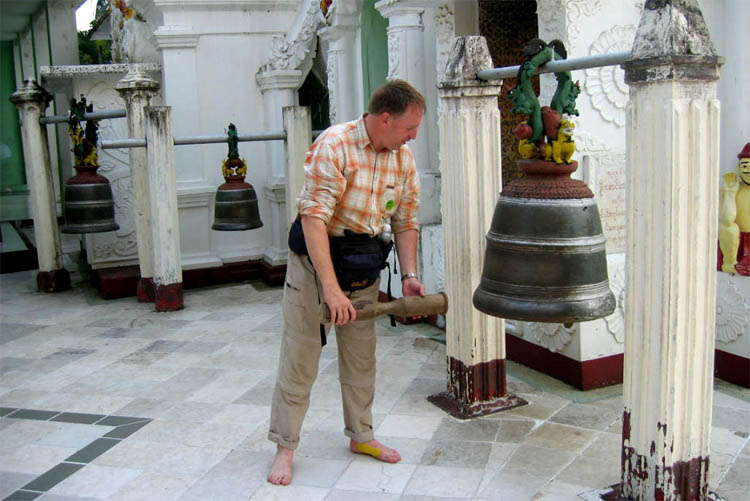
| Uli ringing the bell is going down the spine
|
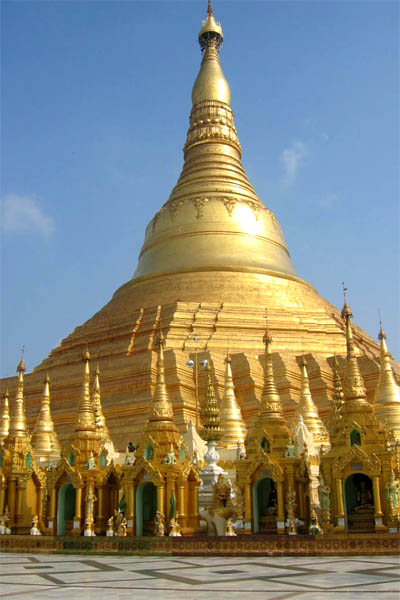
| The stupa again we circle around
|
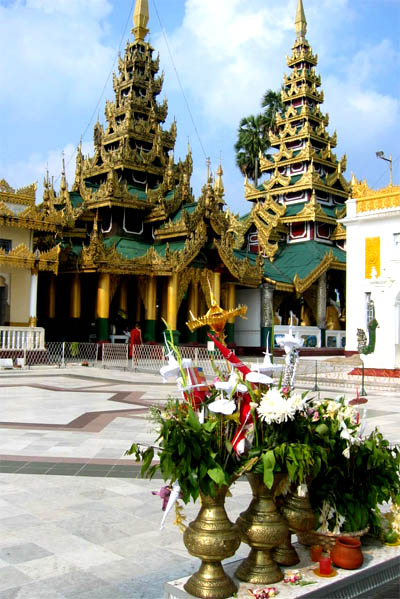
| seeing more temples abound
|
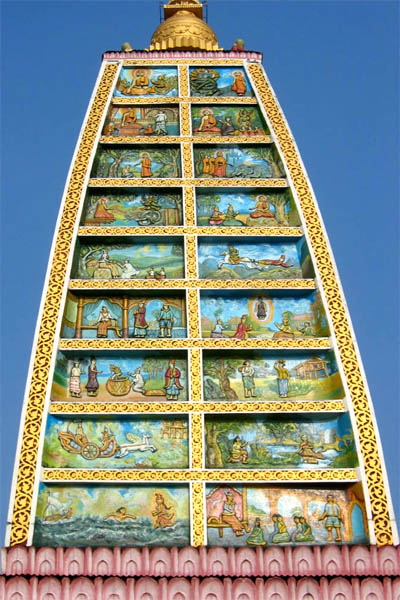
| Temples in all shapes
|
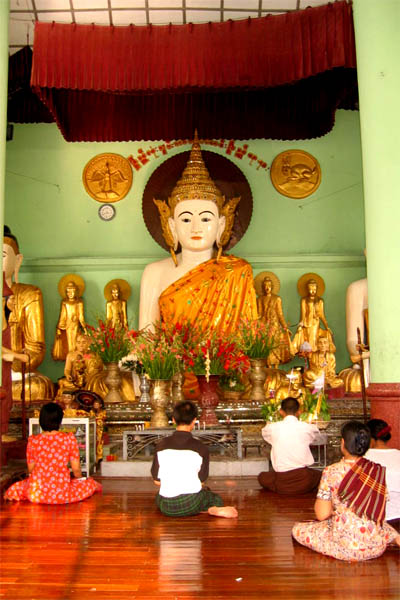
| Altars different as well
|
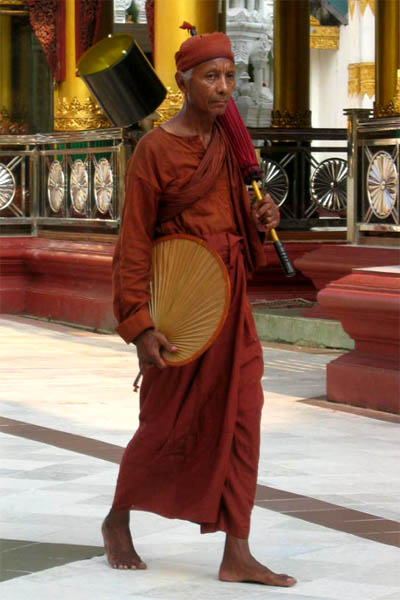
| Monks of all kinds
|
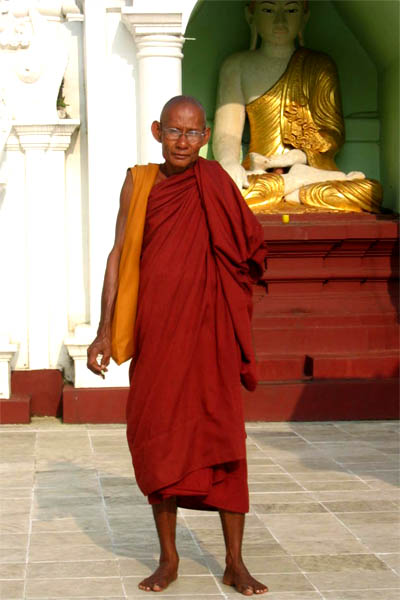
| wandering around
|
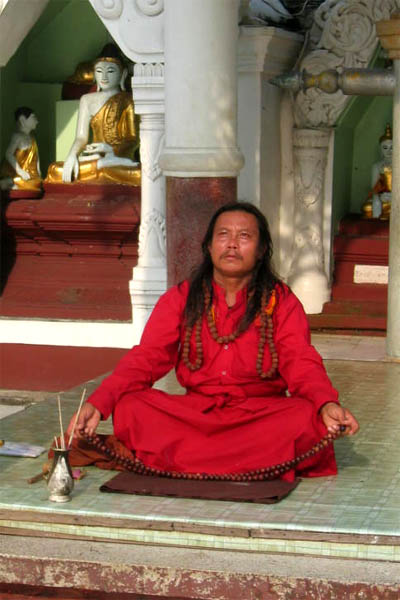
| Worshippers meditating
|
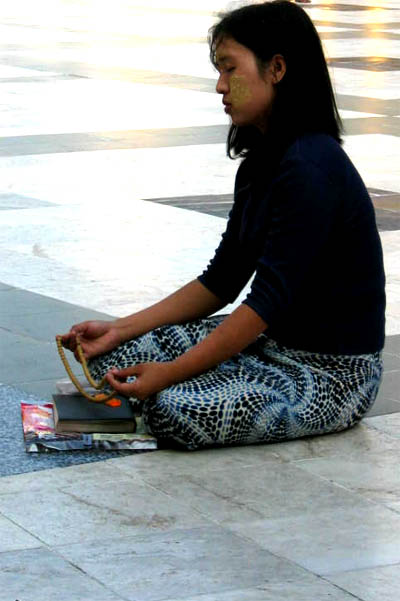
| or just praying
|
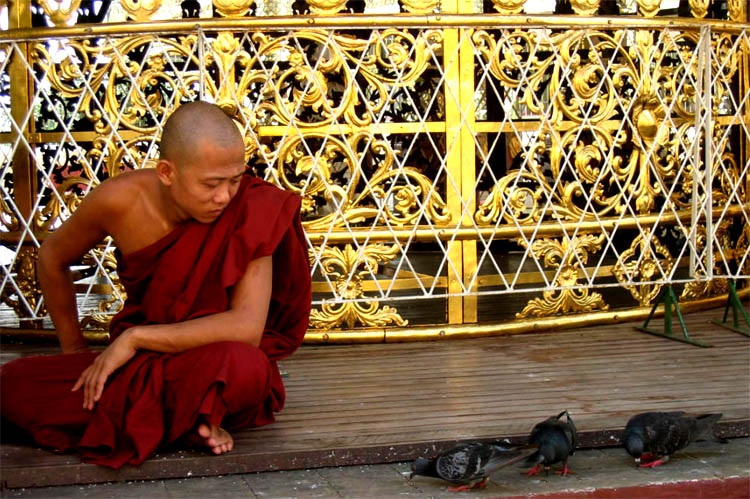
| Young monk con-templating re-incarnation of pigeons and the nirvana
|
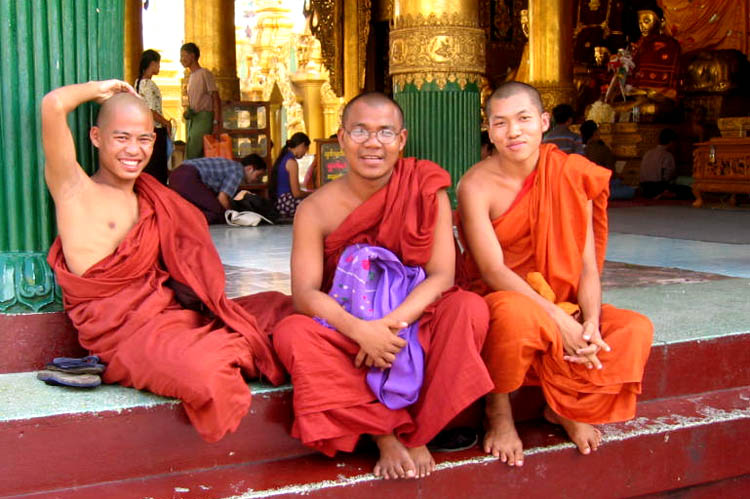
| We are saying good-bye to the wonderful people of Burma
|
OK, that was our trip to Burma or better Myanmar, and my second one. Not that much of an adventure or out of the ordinary, I must admit, but still interesting and relaxing with a lot of fun though. And that is what it is all about: have fun, no stress but more easy going. We did not have to run from one temple to the other, famous or not, but rather visit a market instead if we felt that way. Thus there may be many sights we should have visited or photographed but didn't (still wondering about my missing Mandalay photos), also, many things I could have described more, but nothing is more boring than reading all the sagas behind each temple instead of just admiring the beauty and craftsmanship; pictures can tell more than a long narrative. If you want to know more, then just look up any of the many guidebooks around or in the internet.
| 